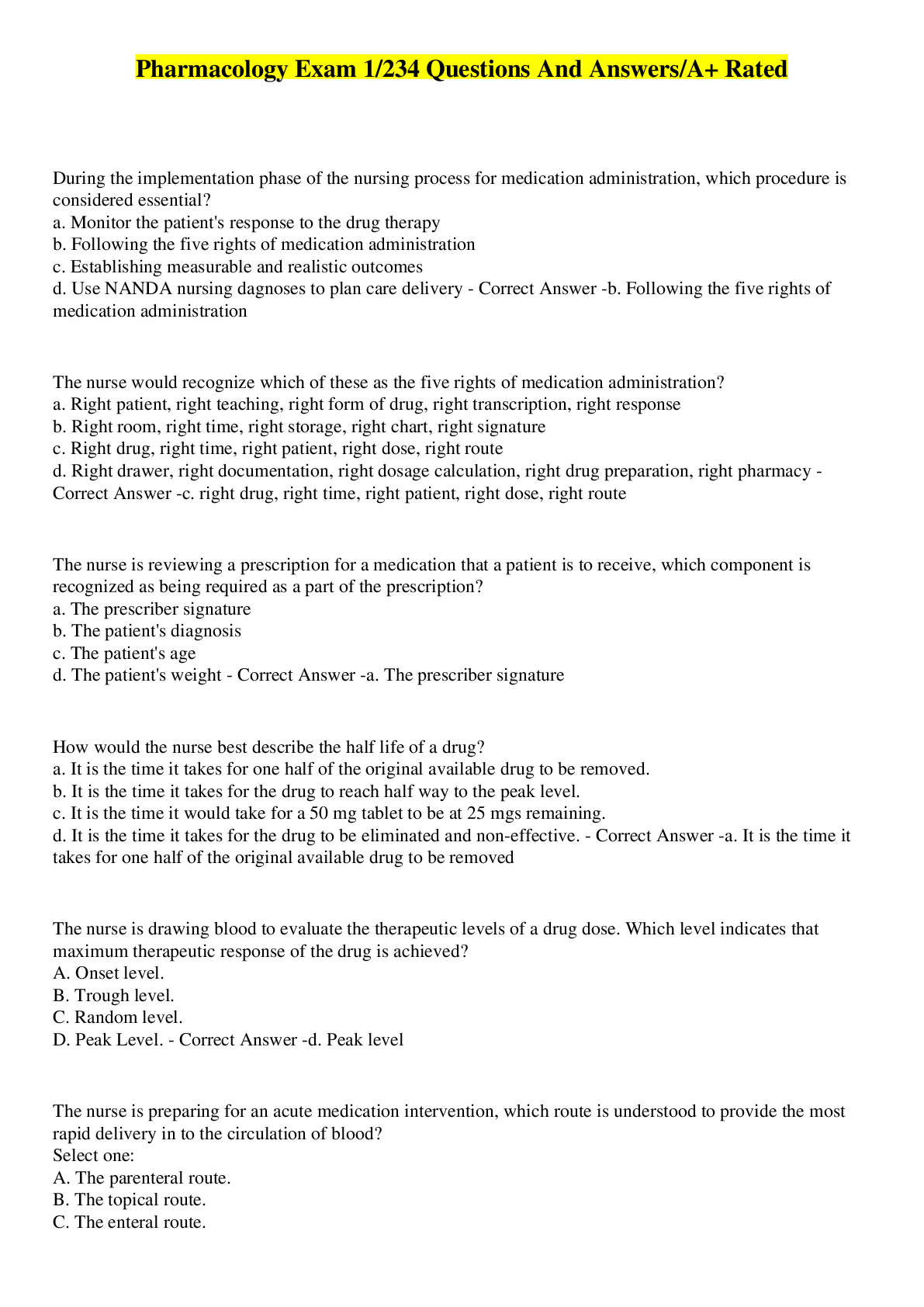*NURSING > EXAM > NR 599 Final Exam (Latest version 2020, scored A): Nursing Informatics for Advanced Practice: Chambe (All)
NR 599 Final Exam (Latest version 2020, scored A): Nursing Informatics for Advanced Practice: Chamberlain College of Nursing_Already Graded A
Document Content and Description Below
Chamberlain College of Nursing NR599 Final Exam (Latest): Nursing Informatics for Advanced Practice NR599 Final Exam (Latest): Nursing Informatics for Advanced Practice: Chamberlain College of Nursing... Part I: Multiple Choice Questions 1. Why is it difficult to integrate information from all hospital departments into a single hospital information system? a. Individual departments want to obtain & maintain specialized systems b. Hospital departments are organized along vertical lines while the continuum of care for patients flows along horizontal lines c. Patient care systems & financial management systems are incompatible with each other d. Each department is required by law & the Joint Commission on Accreditation of Hospitals & Health Care Organizations to maintain specific information for billing & accreditation purposes e. Individual departments do not see the value in comprehensive patient records 2. Which of the following groups of activities represent challenges to the technologist when building an integrated hospital information system? a. Synthesizing different types of information into a cohesive whole, getting all departments to agree to a single billing procedure, realigning traditional departments into a case management model b. Synthesizing different types of information into a cohesive whole, getting all departments to agree to a single care model, realigning traditional departments into a case management model c. Allowing specific departments to retain their individualized information systems, getting all departments to agree to a single billing procedure, realigning traditional departments into a case management model d. Synthesizing different types of information into a cohesive whole, getting all departments to agree to a single billing procedure, keeping all hospital departments within the traditional vertical structure e. Allowing all departments to retain their individual information systems, allowing all departments to have their own billing system, keeping all hospital departments separate but equal 3. The conceptual components of informatics are: a. Management, processing, & transformation b. Data, information, & paradigms c. Data, information, & knowledge d. Management, processing, & data e. Management, processing, & knowledge 4. Several colleges have suggested that Wikipedia™ be banned as a resource for academic papers. Which of the following statements support that ban? a. Wikipedia™ cannot be considered a primary source of information b. Wikipedia™ cannot be considered an authoritative source of information c. Wikipedia™ is sometimes unreliable d. Wikipedia™ allows almost anyone to edit most of its articles e. All of the above 5. When would you use the word “and” in a literature search? a. When you want to eliminate citations with a certain term in the title b. When only one of multiple search terms must be in the title of the citation c. When all of multiple search terms must be in the title of the citation d. When you want to index a particular article e. When you want the abstract of the citations to be included in the literature search 6. What is a refereed journal? a. Any scholarly journal b. Any journal with a title that begins with “The Journal of…” c. A journal that uses a blind review process to determine the suitability and worth of articles received for publication d. Any journal that can be found on Ohio Link or through Kelvin Smith Library e. Any journal edited by someone with a Ph.D. 7. Several indexes to scholarly literature can be found in the library. Which one of these indexes has the most applicability to the profession of Nursing? a. MEDLARS b. MEDLINE c. ERIC d. CINAHL e. Social SciSearch 8. Why are informatics nurse specialists and nurse scholars so interested in nursing nomenclatures, taxonomies, and classification? a. It gives them something to do b. The information is used to capture, store, and manipulate data in electronic health records c. It enhances the credibility of the profession d. It allows nurses to clearly define the profession for physicians e. All of the above 9. How many classification systems are recognized by the American Nurses Association? a. Six b. Four c. Thirteen d. Seven e. None 10. Which three data sets must be used together to complete the nursing process? a. NANDA, Clinical Care Classification (CCC), International Classification of Nursing Practice (ICNP) b. NANDA, Nursing Intervention Classification, Patient Care Data Set c. NANDA, Nursing Outcome Classification, SNOMED RT d. NANDA, Nursing Intervention Classification, Nursing Outcome Classification e. NANDA, Omaha System, SNOMED RT 11. Which of the following are forces that impact the nursing profession and are causing a growing interest in information technology? a. Change from a retrospective to a prospective reimbursement system b. Changing standards of health care accreditation agencies c. Transformation of the health care system from a provider-driven monopoly to a customer-centered, market driven, health oriented marketplace d. Shifting emphasis on automation for its own sake to data collection for survival & improvement e. All of the above 12. Which of the following statements is a definition of Nursing Informatics? a. Collected information technologies concerned with medical patient care &decision making b. Use of information technology management concepts & methods to support the delivery of patient care c. Complex processing of data by a computer to produce new kinds of information d. Any use of information technology by nurses in relation to the care of patients, administration of health care facilities, & educational preparation of individuals to practice nursing e. Combination of computer science, information science, & nursing science designed to assist in the management & processing of nursing data 13. The functional components of informatics are: a. Data, information, & knowledge b. Management, processing, & transformation c. Management, processing, & information d. Processing, transformation & knowledge e. None of the above 14. The role of the Informatics Nurse Specialist (INS) encompasses multiple activities ranging from the development of Informatics theory to the ongoing maintenance & provision of enhancements to information systems. Which of the following statements describes the education, experience, & user groups that concern an INS? a. Formal education & practical experience in using computers; supports the automation needs of critical care nurses b. Formal education & practical experience in using computers; supports the automation needs of maternal-child nurses c. Formal education & practical experience in using computers; supports the automation needs of community health nurses d. Formal education & practical experience in using computers; supports the automation needs of all e. Formal education & practical experience in using computers; supports the automation needs of psychiatric nurses 15. Security can be defined as: a. The right of individuals to determine at what time, in what way, & to what extent information about them is communicated to others b. Physical protection of information from unauthorized access, modification, & destruction c. An expectation that information collected will be used for the purpose for which it was gathered d. Organizational beliefs about who generates, stores, retrieves & uses information e. The belief that the existence, purpose, & type of records in system shall be public knowledge 16. Beliefs about who generates, stores, retrieves, & uses information within an organization are known as the organizations: a. Mission for information use b. Philosophy of information use c. Vision of information use d. Framework for information technology development and implementation e. Legal-ethical responsibilities for information use and storage 17. Privacy can be defined as: a. An expectation that information collected will be used for the purpose for which it was gathered b. The right of individuals to determine at what time, in what way, & to what extent information about them is communicated to others c. Protection of information from unauthorized access, modification, & destruction d. Organizational beliefs about who generates, stores, retrieves & uses information e. All of the above 18. Confidentiality can be defined as: a. Organizational beliefs about who generates, stores, retrieves & uses information b. Physical protection of information from unauthorized access, modification, & destruction c. An expectation that information collected will be used for the purpose for which it was gathered d. The right of individuals to determine at what time, in what way, & to what extent information about them is communicated to others e. The belief that the existence, purpose, & type of records in system shall be public knowledge 19. As a nurse practitioner, you are questioned by a patient about the usefulness of a particular web site for health information. You do not know the web site and have no computer available to access the site in your office. Which of the following replies would be the most appropriate to make to your patient? a. “If the site showed up on your search engine- it must be good. Go ahead and use it!” b. “I don’t really know the site, but here are some things to look for. You can also go to the Health on the Net Foundation and check it out” c. “Have any of your friends used it? What did they think?” d. “No Internet sites have any useful information. Let me give you some written information instead.” e. “What does your doctor think about the site?” 20. Why are nurses’ natural advocates of consumer health applications? a. With the nursing shortage, it lightens the workload b. Nurses are more computer literate than physicians c. Nurses have always taken a leadership role in patient education d. Only nurses are exposed to consumer informatics in school e. It’s easier to get patients to teach themselves than it is to spend the time and teach them 21. A consumer health care application can be described as: a. An intervention providing health care information through technology b. An outcome resulting in patient education c. A care plan detailing the steps in teaching the patient d. A patient’s application to be accepted into an insurance plan e. All of the above 22. The four areas in which Informatics Nurse Specialists practice are: a. Critical care units, neonatal intensive care units, medical-surgical units, pediatric units b. Administration, education, research, clinical practice c. Nursing science, information science, research, computer science d. Hospitals, nursing homes, outpatient clinics, mobile radiology units e. Long term care facilities, nursing homes, nursing administration offices, pediatric intensive care units 23. Which of the following are impediments to the successful implementation of a computerized medical record? a. Oversimplification of user needs b. Oversimplification of the requirements for a new system c. Little understanding of the manual system that the computerized system will be replacing d. Clinicians are not aware of what computerized medical records can and cannot do e. All of the above 24. Which of the following statements represent conditions recommended by the Institute of Medicine for the future electronic health record? a. Users must be confident that the information they have entered will integrate data from all sources reliably b. Clinicians must actively use the record in the clinical process c. Clinicians must understand that the record is a resource for use beyond patient care d. Users must be proficient in the use of information systems in health service organizations e. All of the above 25. Inputs in geographic information systems are frequently derived from: a. Hard copy maps b. Aerial photographs c. Reports & survey documents d. Human input of information e. All of the above 26. Which of the following definitions best describes a Geographic Information System? a. A computer mapping & analysis system that allows large quantities of information to be viewed & analyzed within a geographic context b. A system which allows researchers to study the distribution of disease in a neighborhood c. System which allows the community health nurse to locate a patient’s home without using a map (a Global Positioning System) d. A system which allows research about infant mortality in a particular census tract e. All of the above 27. Which of the following are limitations of Geographic Information Systems? a. Costs are often prohibitive b. Software packages are difficult to learn c. Data from government databases may not be compatible with the GIS being used for research d. None of the above e. All of the above 28. Which of the following statements justifies the need for and use of standardized nursing languages? a. They provide a legal record of patient care b. They support clinical decision making c. They help accumulate information to expand nursing science d. They help exchange data with internal and external systems for research e. All of the above 29. Which of the following are characteristics of a POC (point-of-care) information system? a. Supports care delivery processes b. Device for input & output of information is at the point of care c. POC system is interfaced or integrated with other hospital systems d. All of the above e. None of the above 30. Which of the following statements reflect goals that health care facilities might consider when moving to a POC system? a. Collect data at the source & present it where & when it is needed b. Minimize documentation time & eliminate redundancies & inaccuracies in charting c. Improve timeliness of documentation d. Optimize information access e. All of the above 31. Which of the following pairs of items are examples of quantitative benefits of point of care (POC) systems? a. Cost avoidance & revenue increases b. Improved process & improved patient outcomes c. Improved patient data & direct savings d. Improved patient outcomes & direct savings e. Potential savings & improved patient satisfaction 32. Which of the following pairs of items are examples of qualitative benefits of point of care (POC) systems? a. Improved process & improved patient outcomes b. Cost avoidance & potential savings c. Improved process & cost avoidance d. Improved patient outcomes & improved patient data e. Revenue increases & improved patient data 33. To be able to effectively implement a point-of care system, you need all of the following except: a. Clear goals & objectives b. A prototype system as a model c. Integration with other departments within the institution d. A team approach to system development 34. In moving a Hospital towards a POC system, multiple problems may emerge. Which of the statements listed below best describes a problem that may impact the entire institution? a. Software is not clinician friendly b. Some desired features may not be available in the chosen system c. Full sized terminals at the bedside may cause space and ergonomic (human factors) problems d. Existing computer system infrastructure may not be able to handle the additional workload of the new computers 35. Which of the following groups of items best represent the characteristics of a point of care system? a. Support of care delivery processes, terminals at the central nurse station, automated data entry & retrieval, integration with other information systems b. Support of care delivery processes, terminals at the central nurse station, manual data entry & retrieval, integration with other information systems c. Support of care delivery processes, terminals at the bedside or point of care, automated data entry & retrieval, integration with other information systems d. Support of care delivery processes, terminals at the bedside or point of care, manual data entry & retrieval, integration with other information systems 36. Which of the following situations represent drawbacks to implementing a POC system? a. Expensive to buy, customize, & install b. Status quo of organization is disturbed c. Change in organization is required for implementation to proceed smoothly d. Software may not be clinician friendly e. All of the above 37. A nursing diagnosis is best described by which of the following statements? a. A measurable patient condition or perception resulting from one or more nursing interventions b. A taxonomy of nurse-sensitive patient outcomes c. Any direct care treatment that a nurse performs on behalf of a client d. A clinical judgment about an individual, family or community’s responses to actual or potential health problems and life processes e. Assessment activities to identify nursing diagnosis &gatherdata for physicianidentification of a medical diagnosis 38. In which stage of the five level patient record would information from alternative forms of health care be included? a. Electronic patient record b. Automated medical record c. Provider base electronic medical record d. Computerized medical record e. Electronic health record 39. Why is there an absence of nursing data in national and regional databases? a. The profession cannot agree upon & offer a set of clearly defined, reliable & standardized data elements b. The profession’s diversity does not require standardization of data c. The data collected by Nursing is not useful to Third Party Payers & does not need to be collected d. The existence of a standardized Nursing language makes this unnecessary 40. Which of the following statements best describes why the Nursing intervention classification (NIC) is important to Nursing Informatics? a. Each NIC intervention has a unique number which allows computerization of the information b. Each NIC intervention has been linked with a nursing diagnosis & with an Omaha system problem c. Each NIC intervention has been linked with a specific NOC d. Each NIC intervention is part of a comprehensive, standardized language specific to the practice of nursing 41. Heuristics can be defined as the study of: a. Holographic images b. Rules of thumb based on a person’s past experiences c. The use of natural language in robots d. Computer chips that give sight & hearing to robot 42. The thirteen data sets approved by the American Nurses Association include which of the following lists? a. SNOMED RT, NANDA, NIC, NOC, International Classification of Disease-10 (ICD-10) b. Omaha System, NIC, NOC, International Classification for Nursing Practice, Common Procedural Terminology (CPT Codes) c. Perioperative Data Set, Nursing Management Minimum Data Set, NIC, NOC, Omaha System d. SNOMED RT, International Classification of Disease-10 (ICD-10), Common Procedural Terminology (CPT Codes), International Classification for Nursing Practice, ABC Code by Alternative Link Practice 43. Knowledge can be defined as: a. Discrete entities described objectively b. Discrete entities described without interpretation c. Information that has been synthesized d. Data that are interpreted e. Data that are organized 44. Knowledge can be transformed into which of the following a. New knowledge b. Decisions c. Discoveries d. Wisdom e. All of the above 45. The information resources of a hospital are: a. Hardware & software b. Data c. Models to organize the data d. Methods to interpret the data e. All of the above 46. Healthcare computing in hospitals began in the 1980’s and continues to the present. Which of the following activities represents the first efforts (in the 1980’s) toward computerization of healthcare? a. Knowledge creation b. Automation c. Info-mation d. Communication& Integration 47. The older terminologies of health care computing have been replaced with more meaningful, descriptiveterminologies that reflect the movement toward information as a resource. To this end, data entry is now known as:: a. Decision support b. Data extraction c. Safety &OutcomesMeasurement d. Knowledge acquisition e. Data mining 48. The information silos of old hospital systems are now called: a. Consumer resources b. Integrated networks c. Transdisciplinary outcomes d. Decision support systems e. Knowledge repositories Part II: True/False Questions 49. Access to patient-specific, agency-specific, & domain-specific data, information & knowledge, by nurses, has potential to improve ICU decision making a. True b. False 50. The management of information is the functional ability to collect, aggregate, organize, move & represent information in an economical, efficient way. a. True b. False 51. The traditional view of information in the health care environment has been focused on the patient. a. True b. False 52. About 100 people in the US die each day because current paper base health care system introduces errors or delays treatment or limits what health care professionals know a. True b. False 53. Geographic Information Systems have been used in some form since the 1960’s. a. True b. False 54. Comprehensive patient care systems that effectively automate the medical record are not ready for implementation a. True b. False 55. The Continuity of Care Record (CCR) is intended to foster & improve continuity of patient care, to reduce medical errors, & to assure at least a minimum standard of health information transportability when a patient is referred or transferred to, or is otherwise seen by, another provider. a. True b. False 56. It is intrinsically necessary to understand how a system will be used and who will use it. What follows is that the system users must have a voice in the development, design, and use. a. True b. False 57. An organizations’ philosophy of information use provides framework for development of security policies, procedures & practices within organization a. True b. False 58. Nursing Informatics has been designated as an area of specialty nursing practice by the American Nurses Association. a. True b. False 59. A hospital database should contain data that facilitates analysis of traditional management questions relating to employees, salaries, & productivity. a. True b. False 60. A hospital database should contain data necessary to analyze work of clinical departments. a. True b. False 61. A hospital database which integrates data from several computer systems within the institution can directly support patient care. a. True b. False 62. Hospital databases should provide access to patient records for clinical research purposes. a. True b. False 63. New information needs of hospitals must include information that analyzes the cost of patient care &its interdependency with the quality of care. a. True b. False 64. Hospital Information Systems make it possible to collect & store large amounts of data beyond the institution's immediate needs. a. True b. False 65. The traditional view of information in the health care environment has been focused on the patient. a. True b. False 66. Clinical, empirical, & conceptual knowledge are essential components in the development of a discrete Nursing language. a. True b. False 67. The Health on the Net Foundation helps patients to evaluate health related web sites. a. True b. False 68. The professional and/or contractual duty to safeguard the secrecy of patient information regardless of how it is acquired, stored, processed, generated, retrieved, or transmitted is known as confidentiality. a. True b. False 69. Early hospital information systems were primarily used for non patient care procedures such as billing, payroll, & personnel. a. True b. False 70. Consumer health informatics can best be described as tools that empower the patient to make more informed choices about healthcare issues. a. True b. False Part III: Essay Pick ONE of the following questions and answer it directly on the exam. (5 points) 1. Describe one of the VR simulations used in treating phobias. 2. It has been said that the promise of nanotechnology is to “allow doctors to execute curative & reconstructive procedures in the body at cellular & molecular levels. Discuss your concerns & opinions on the use of nanotechnology in medicine. What do you think are the ethical, legal, & moral dilemmas involved in developing & using this new technology? If you could extend life through the use of this technology, would you? Why or why not? 3. We know that nursing unit activities represent the core of patient care in the hospital. Discuss why nurses have been reluctant to become involved in the development and implementation of information systems in health care. 4. Nursing and technology frequently clash in the clinical practice area. Nurses rightly (or wrongly) think that technology interferes with their care of patients and that “high tech” means “high touch” is absent from care. Do you think this is true? Do nurses who are able to use technology (and do) sacrifice their ability to care for patients? 5. Discuss the potential uses of Geographic Information Systems in community health, epidemiology, public health, and hospital administration. Consider such topics as the aging population, distribution of health care, distribution of care services, and development of nursing knowledge. [Show More]
Last updated: 1 year ago
Preview 1 out of 14 pages
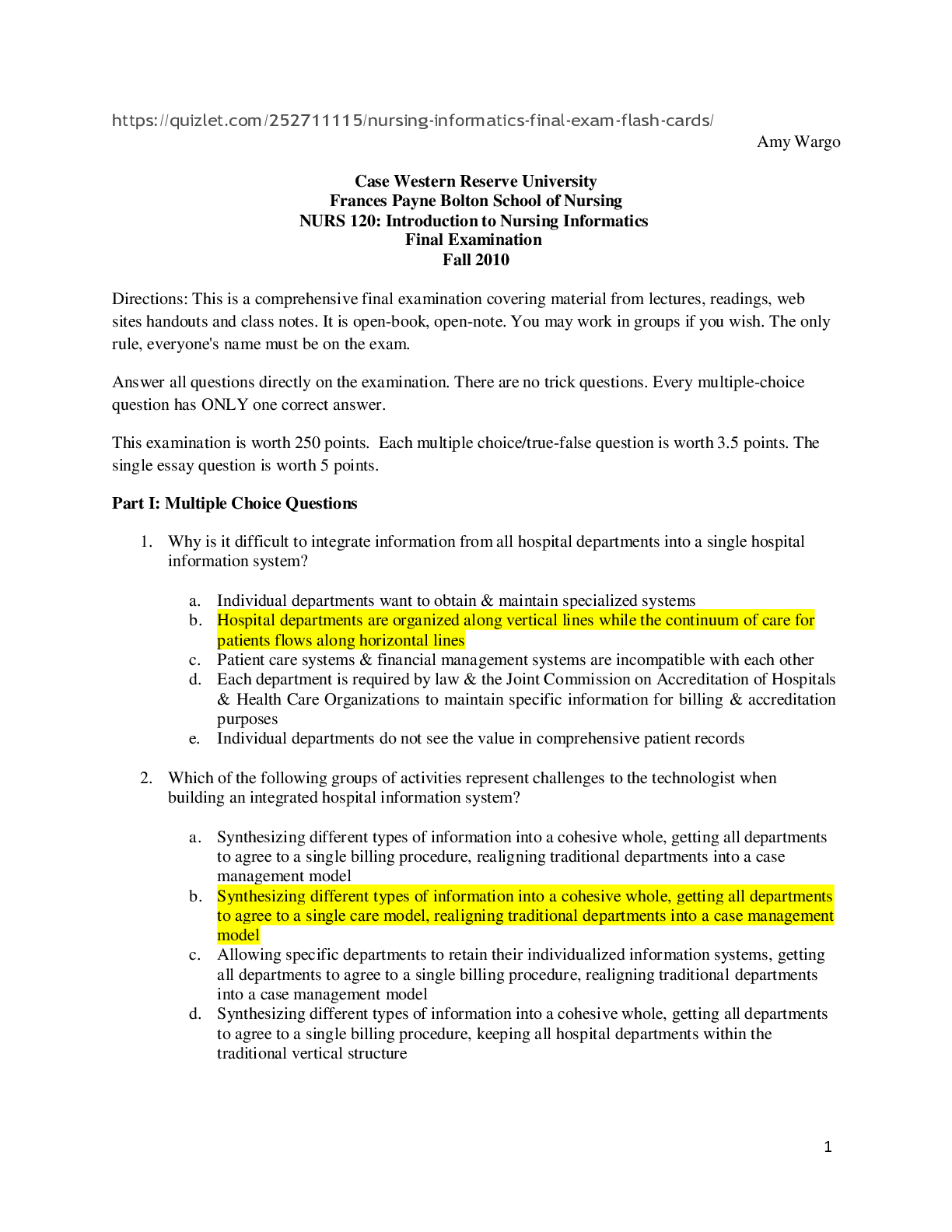
Reviews( 0 )
Document information
Connected school, study & course
About the document
Uploaded On
Apr 10, 2021
Number of pages
14
Written in
Additional information
This document has been written for:
Uploaded
Apr 10, 2021
Downloads
0
Views
38


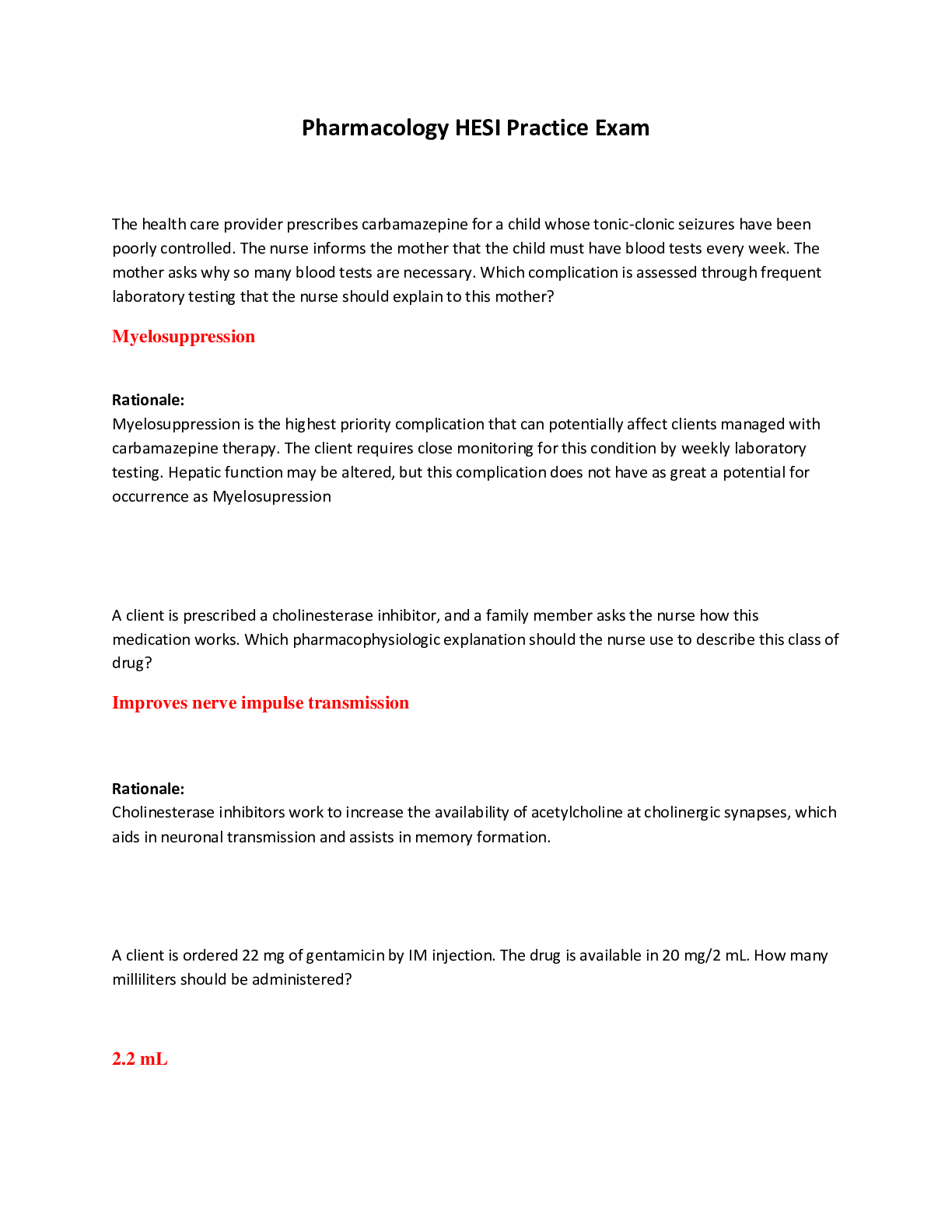
.png)
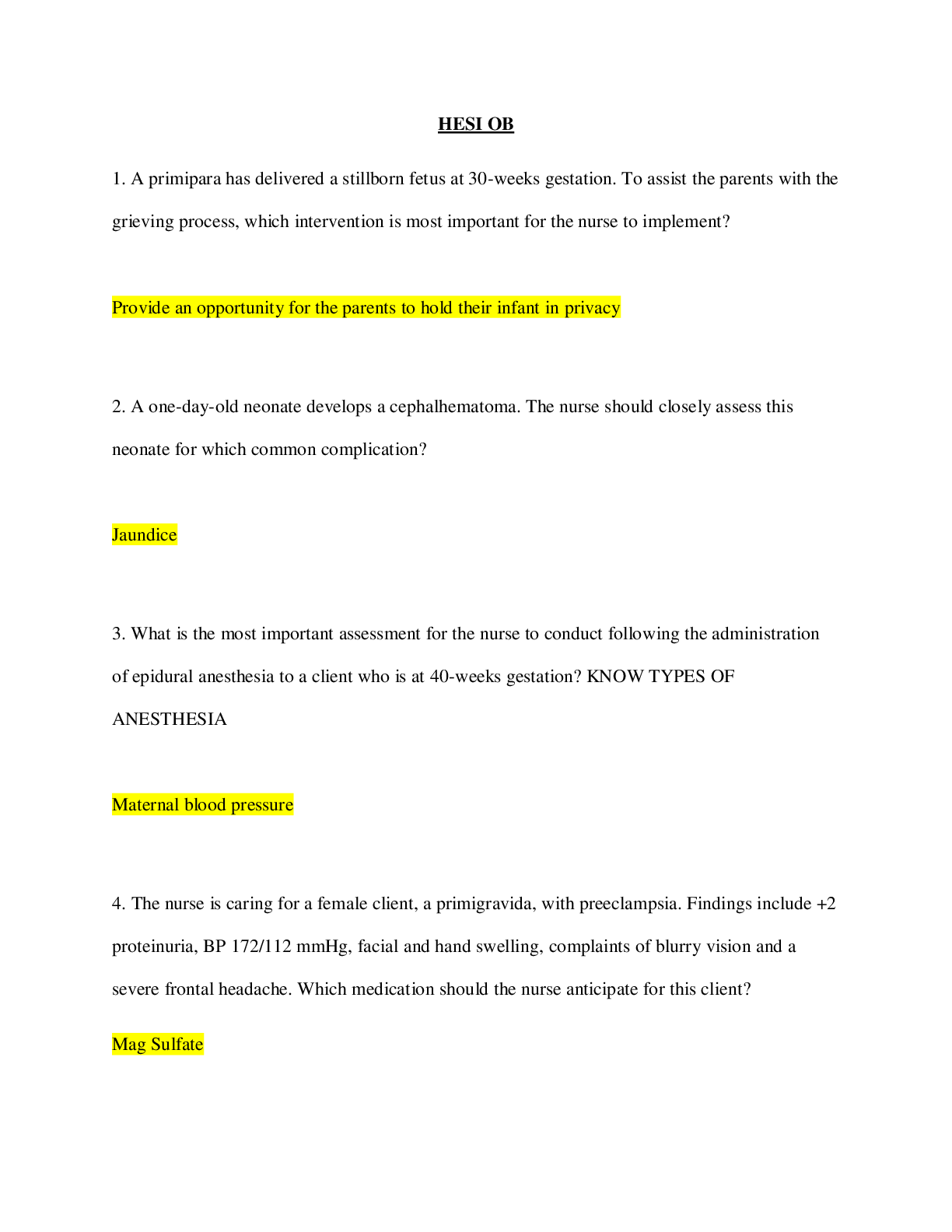
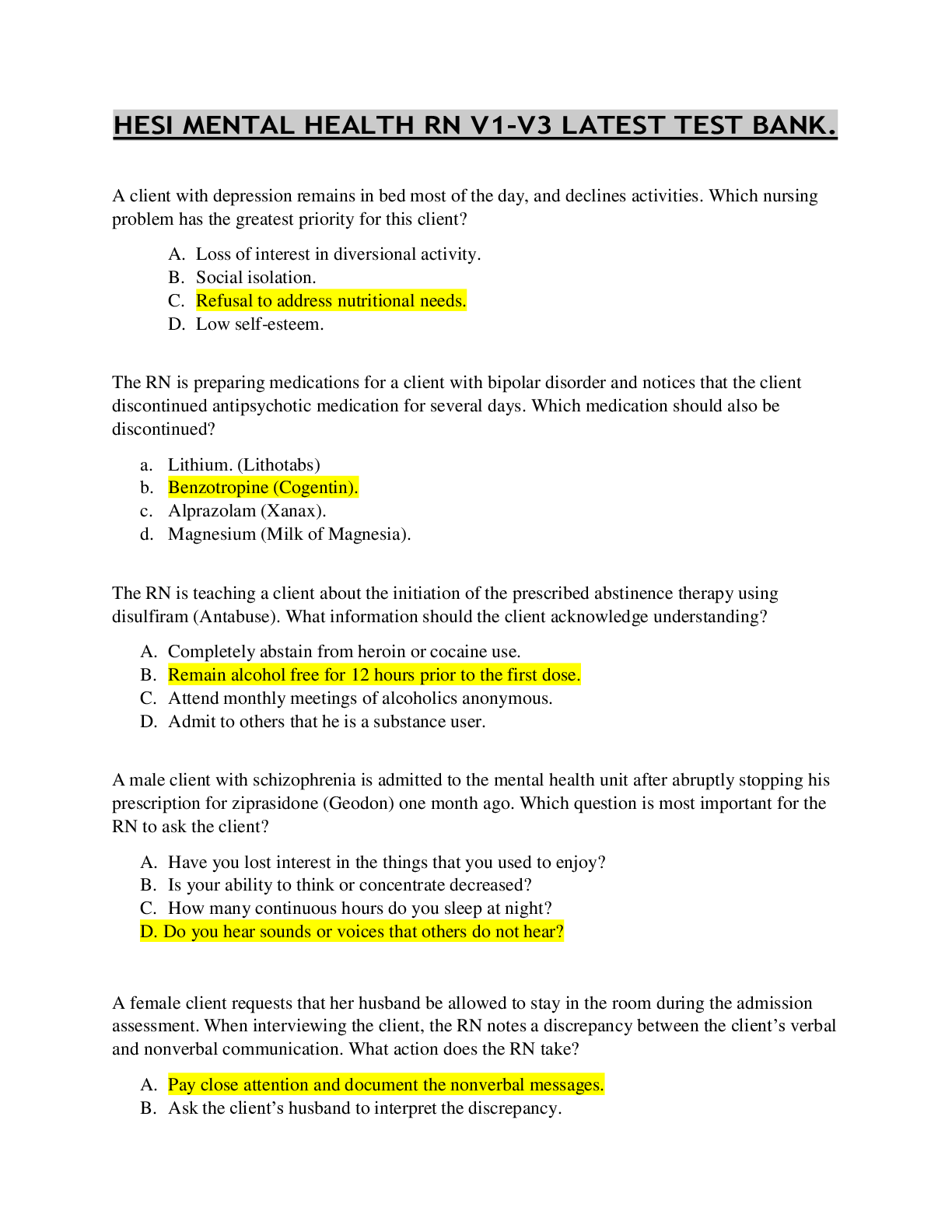

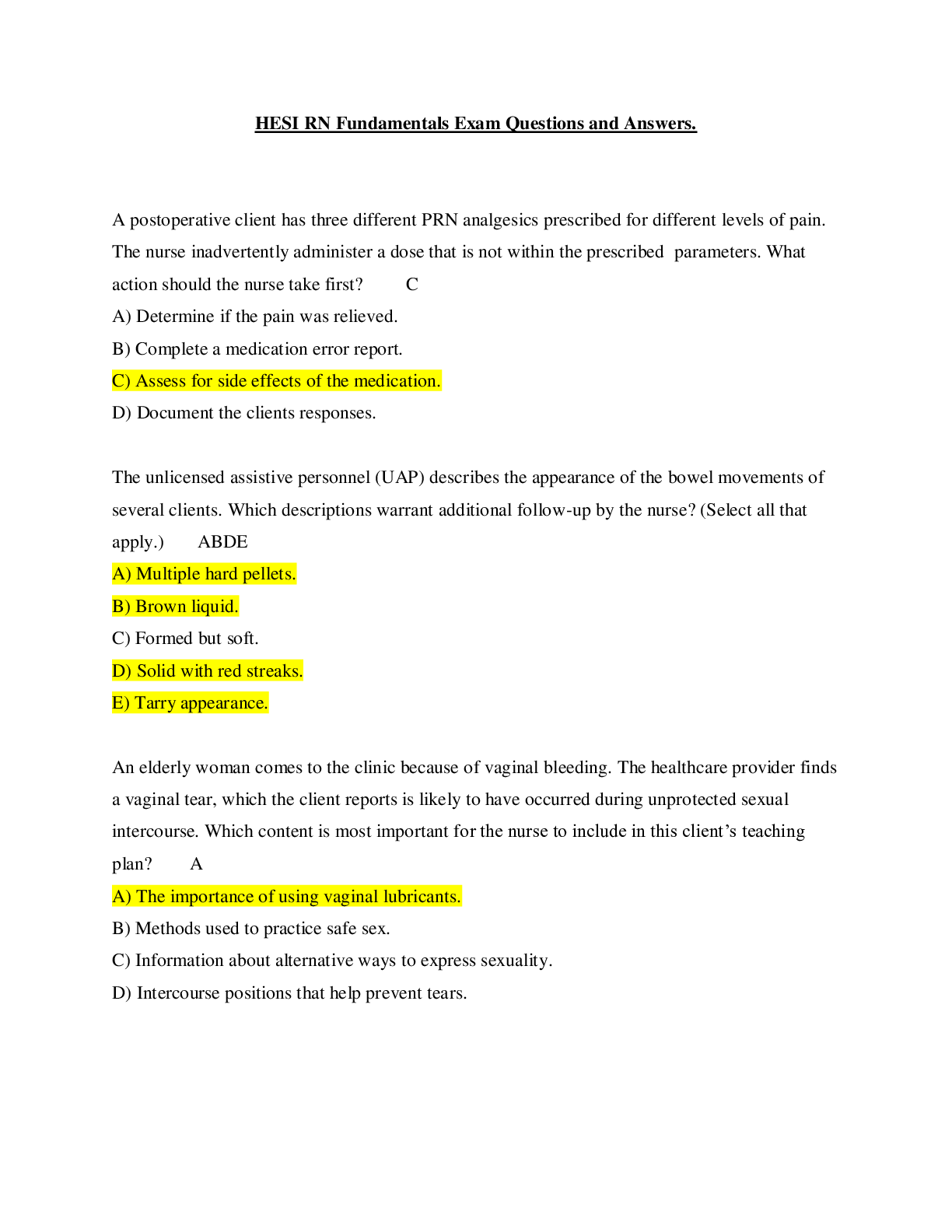
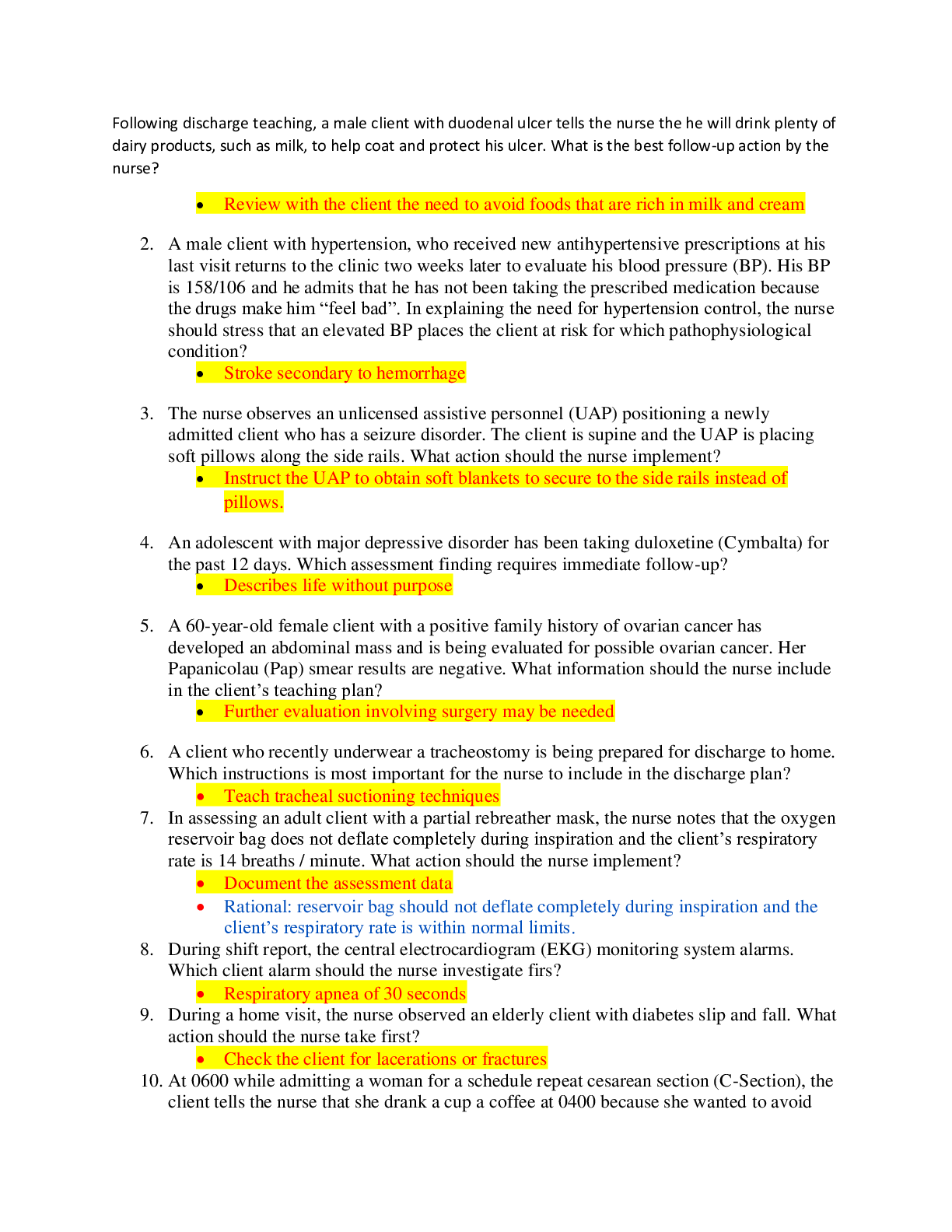
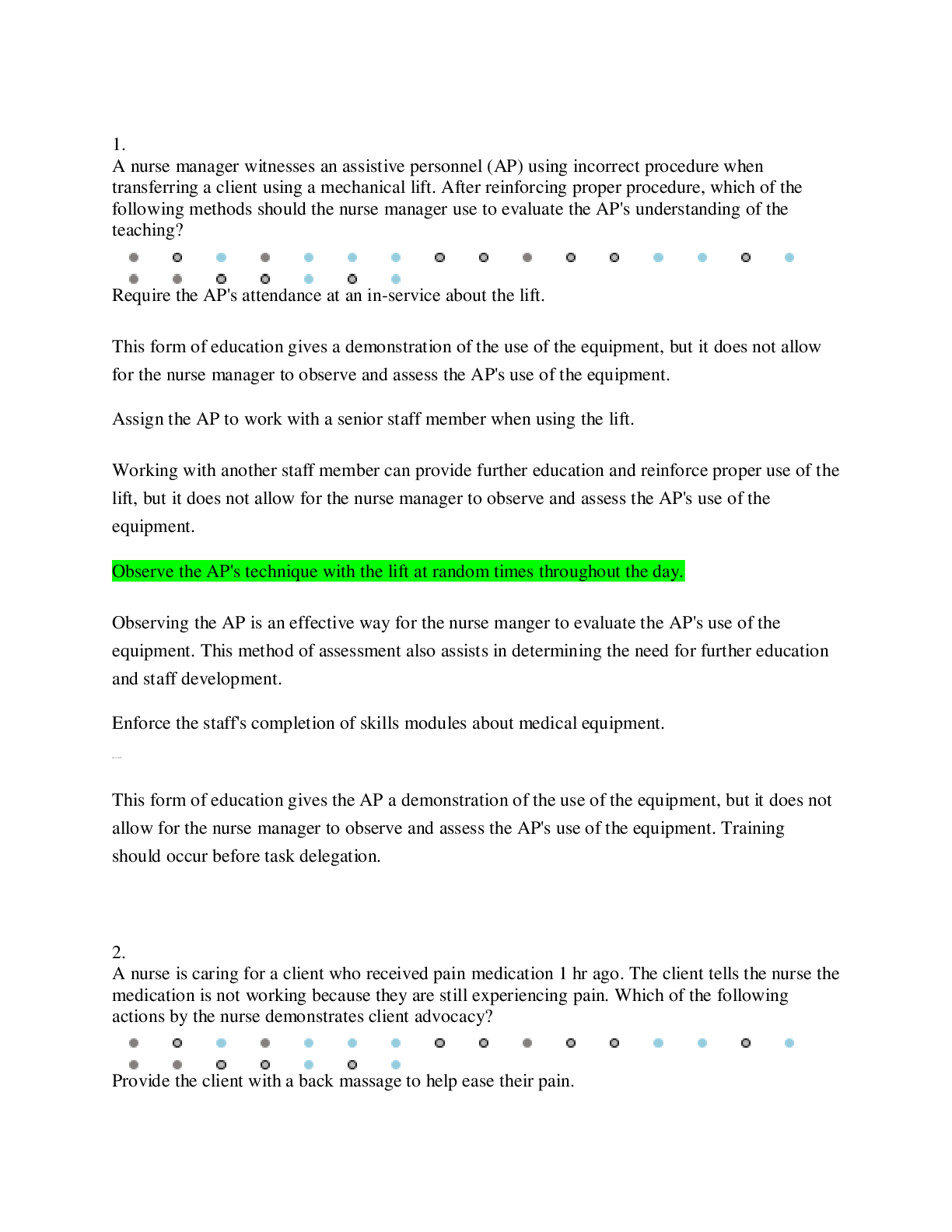
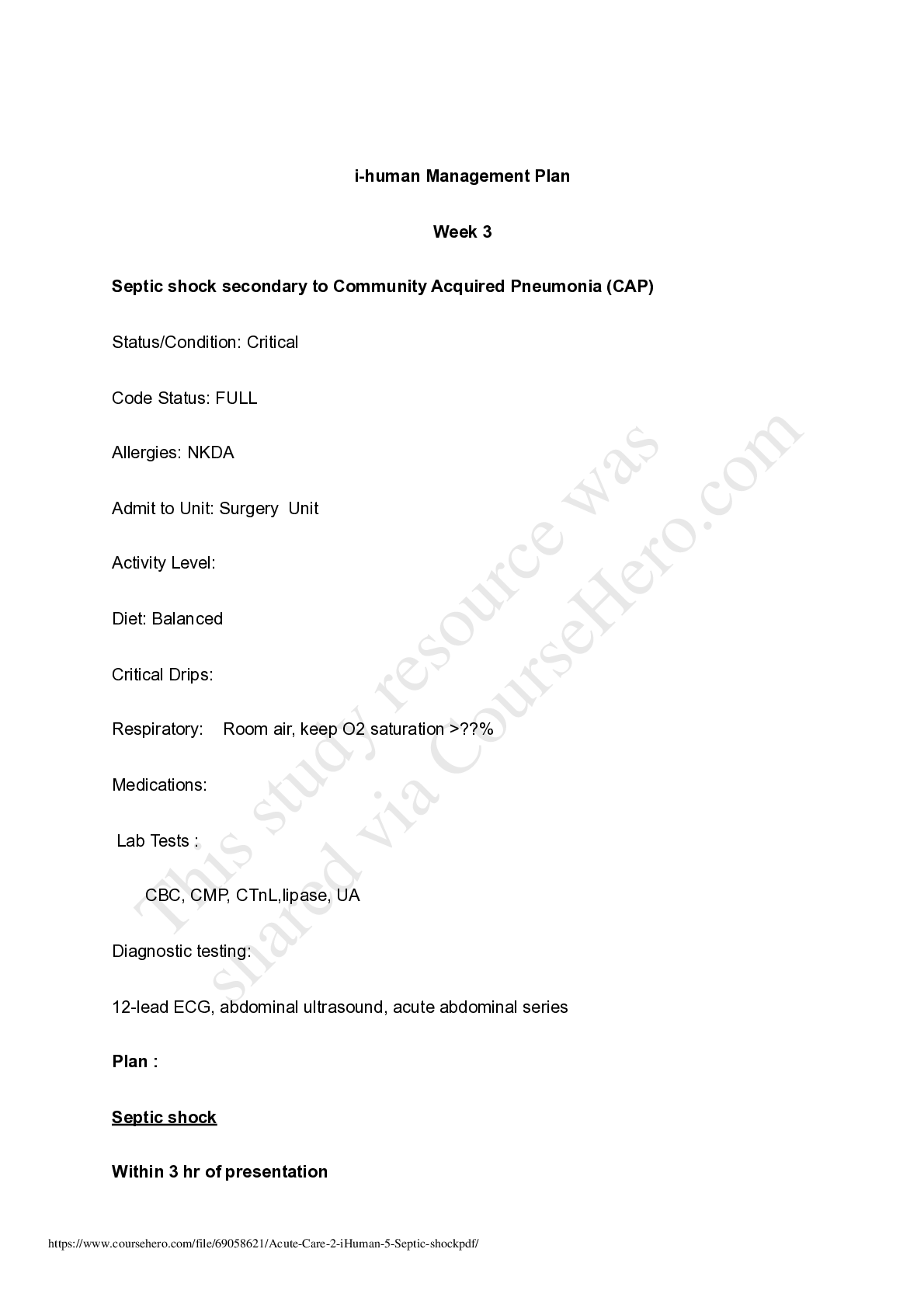
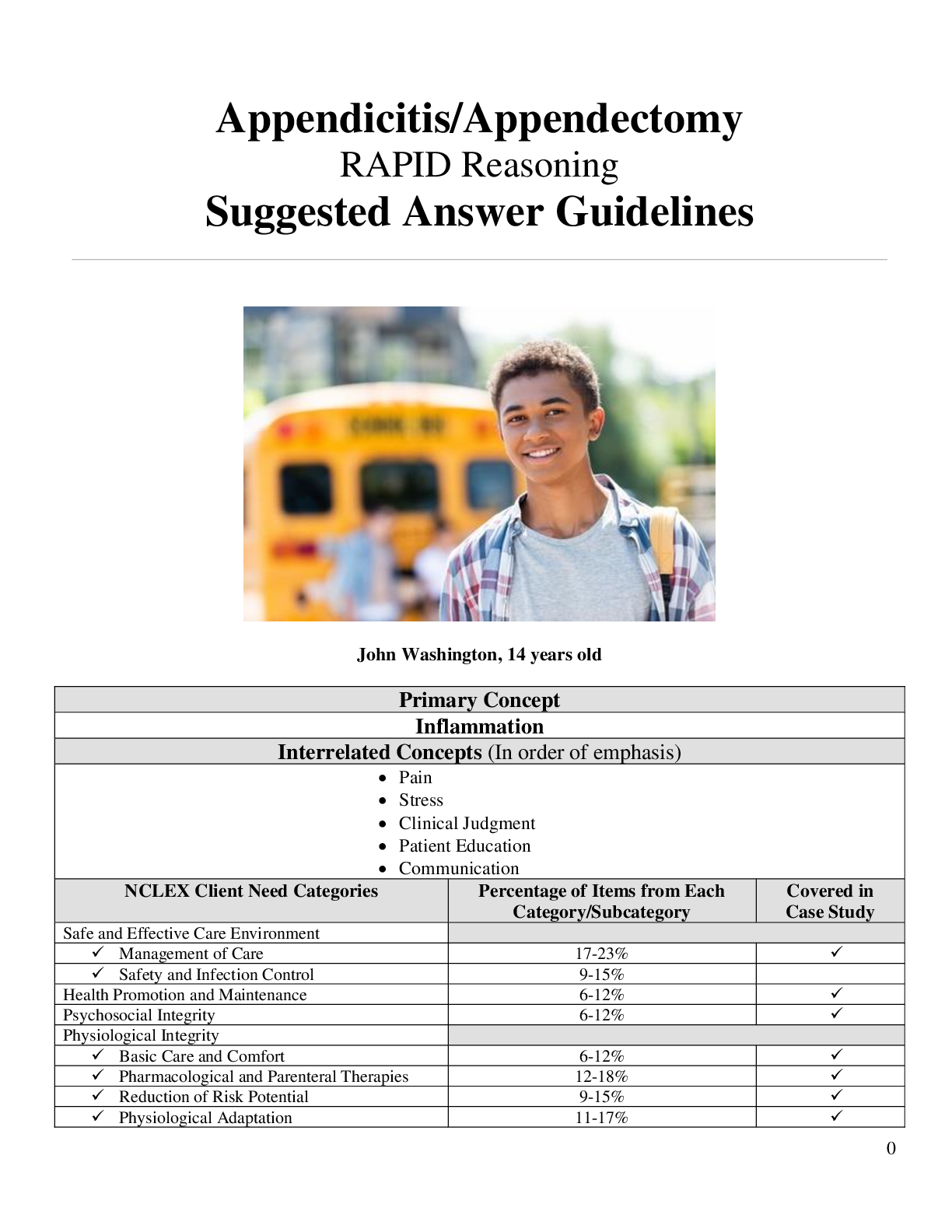
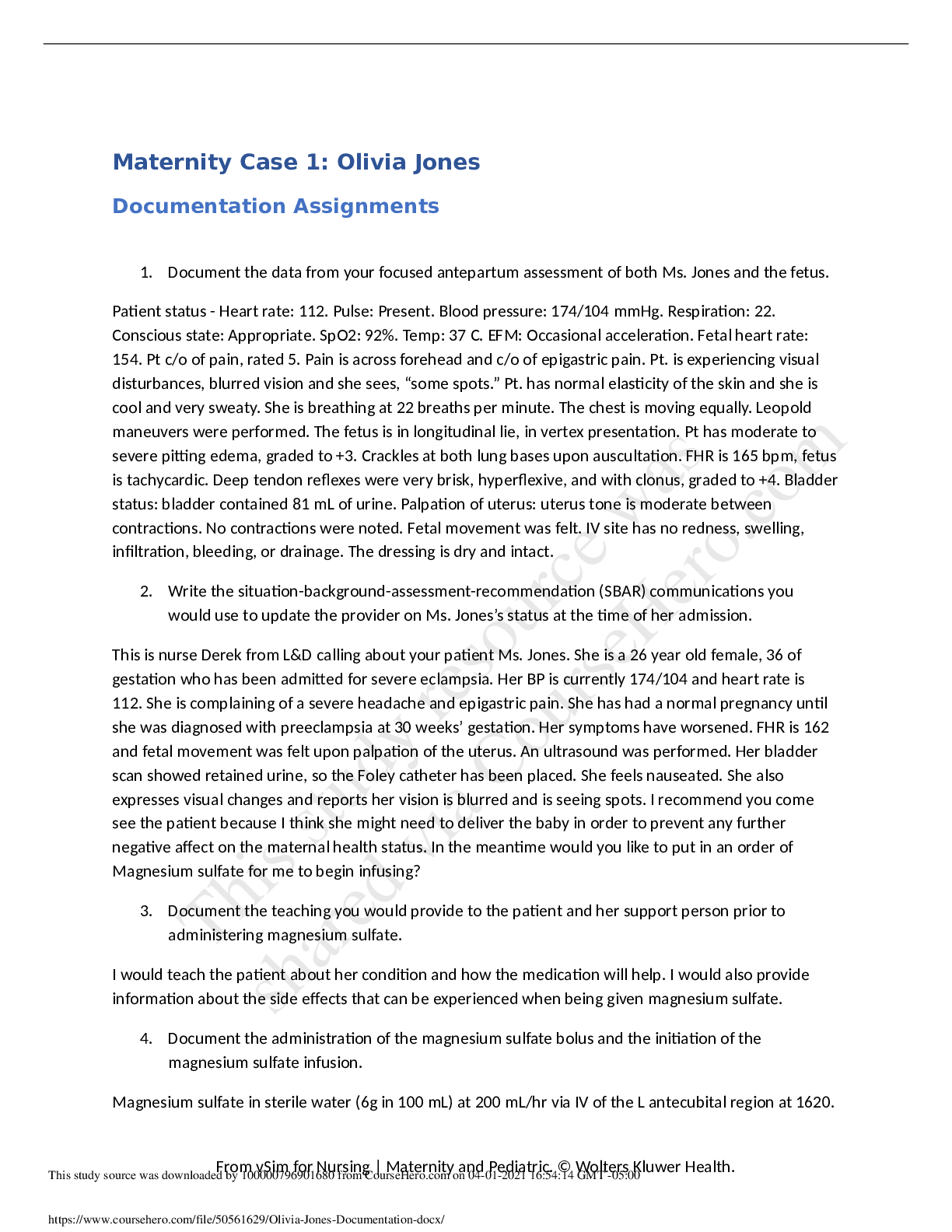
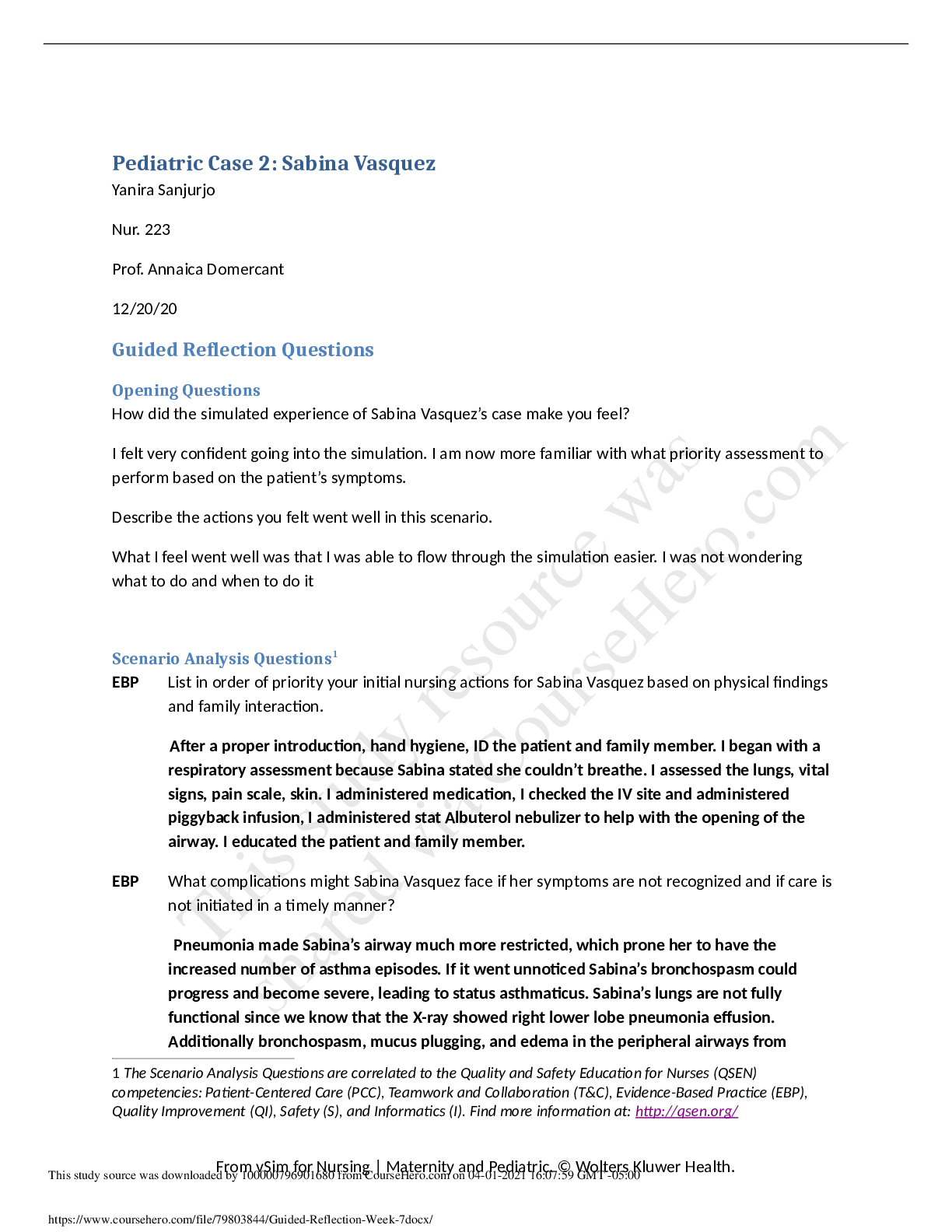
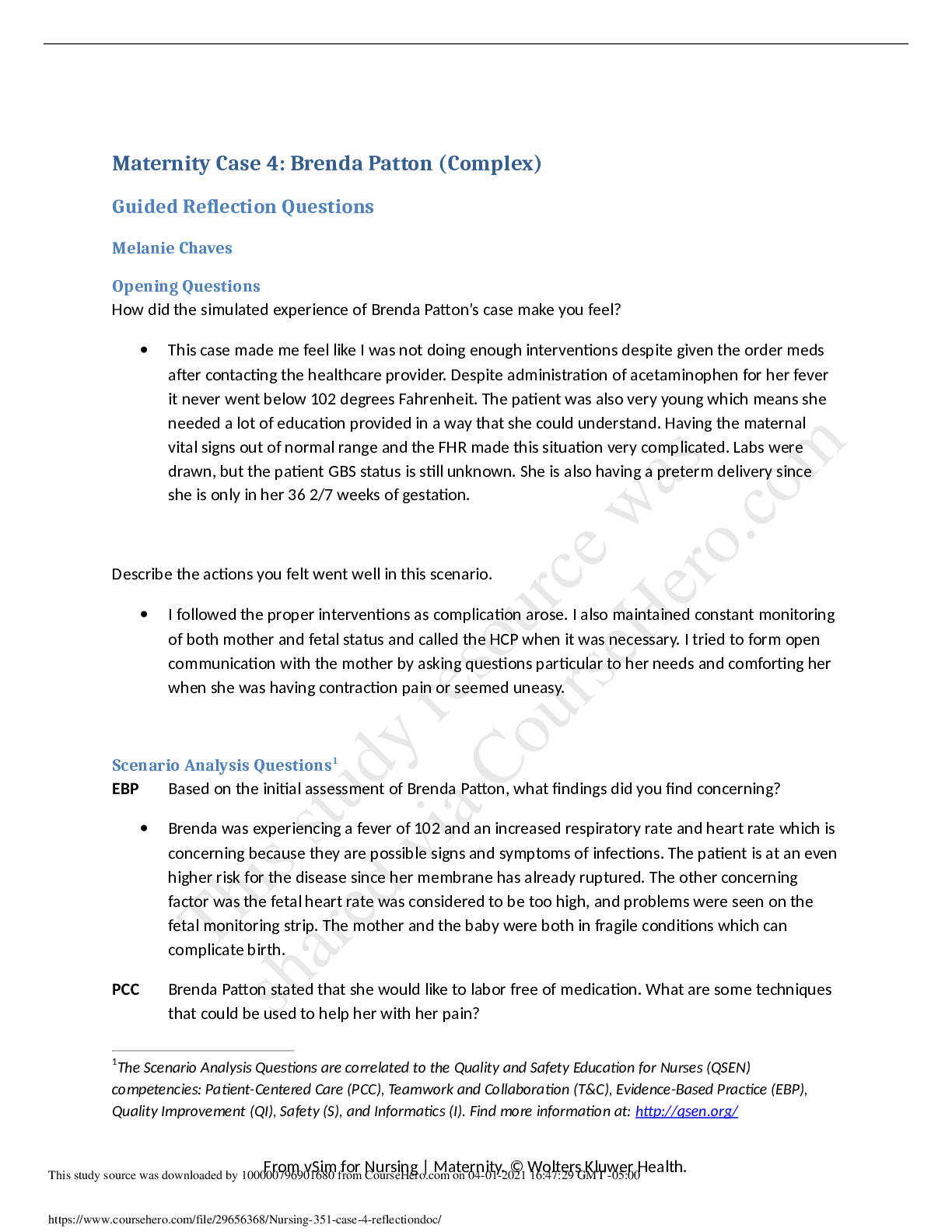
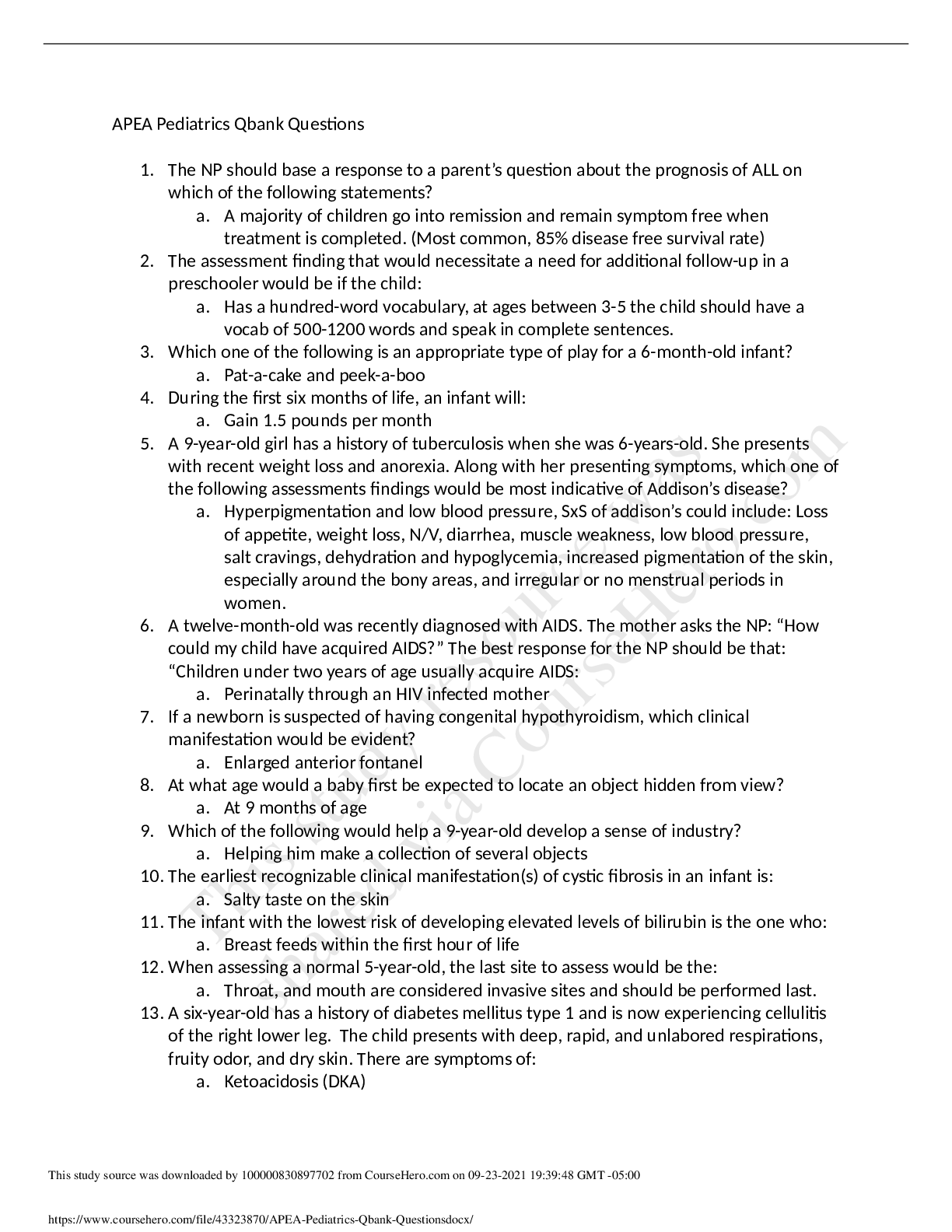
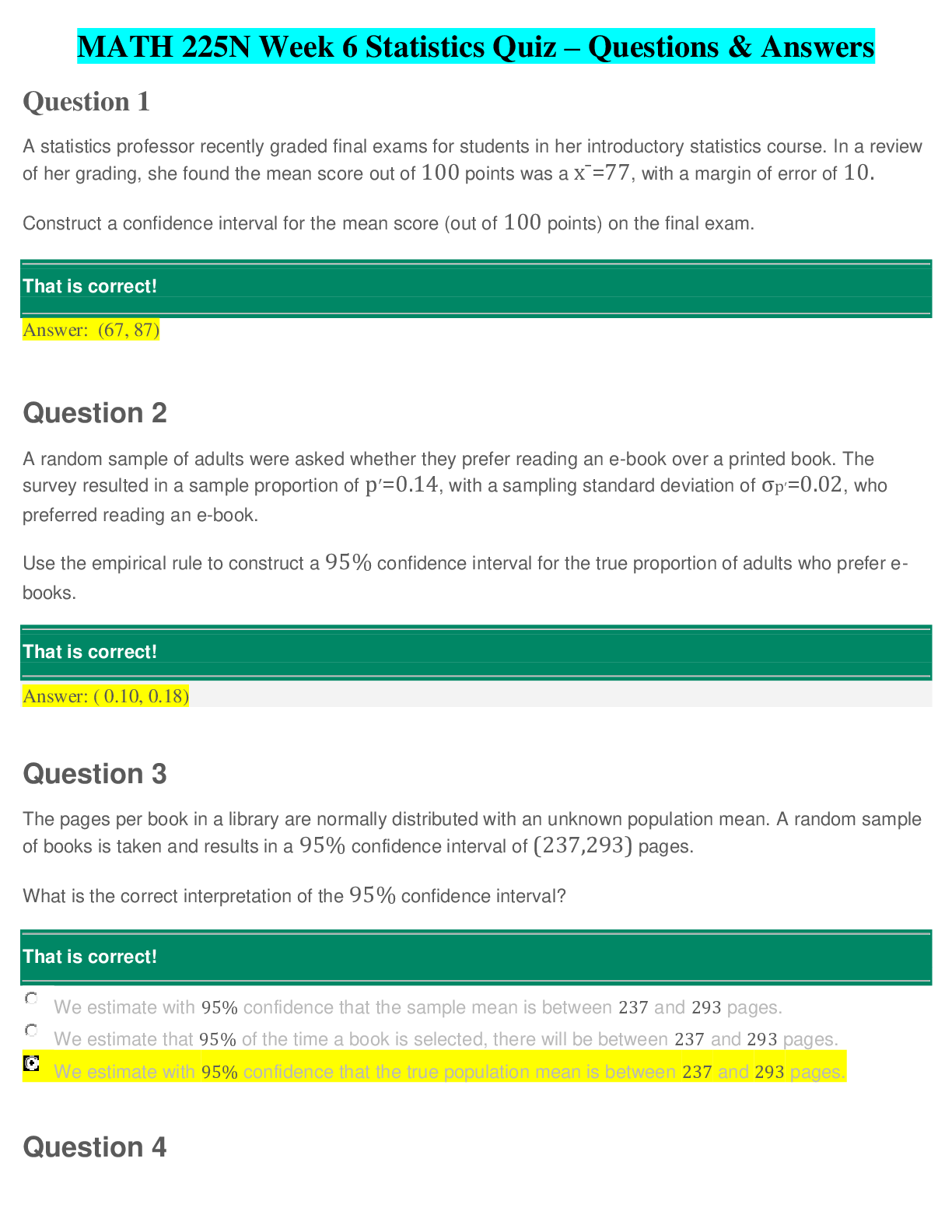

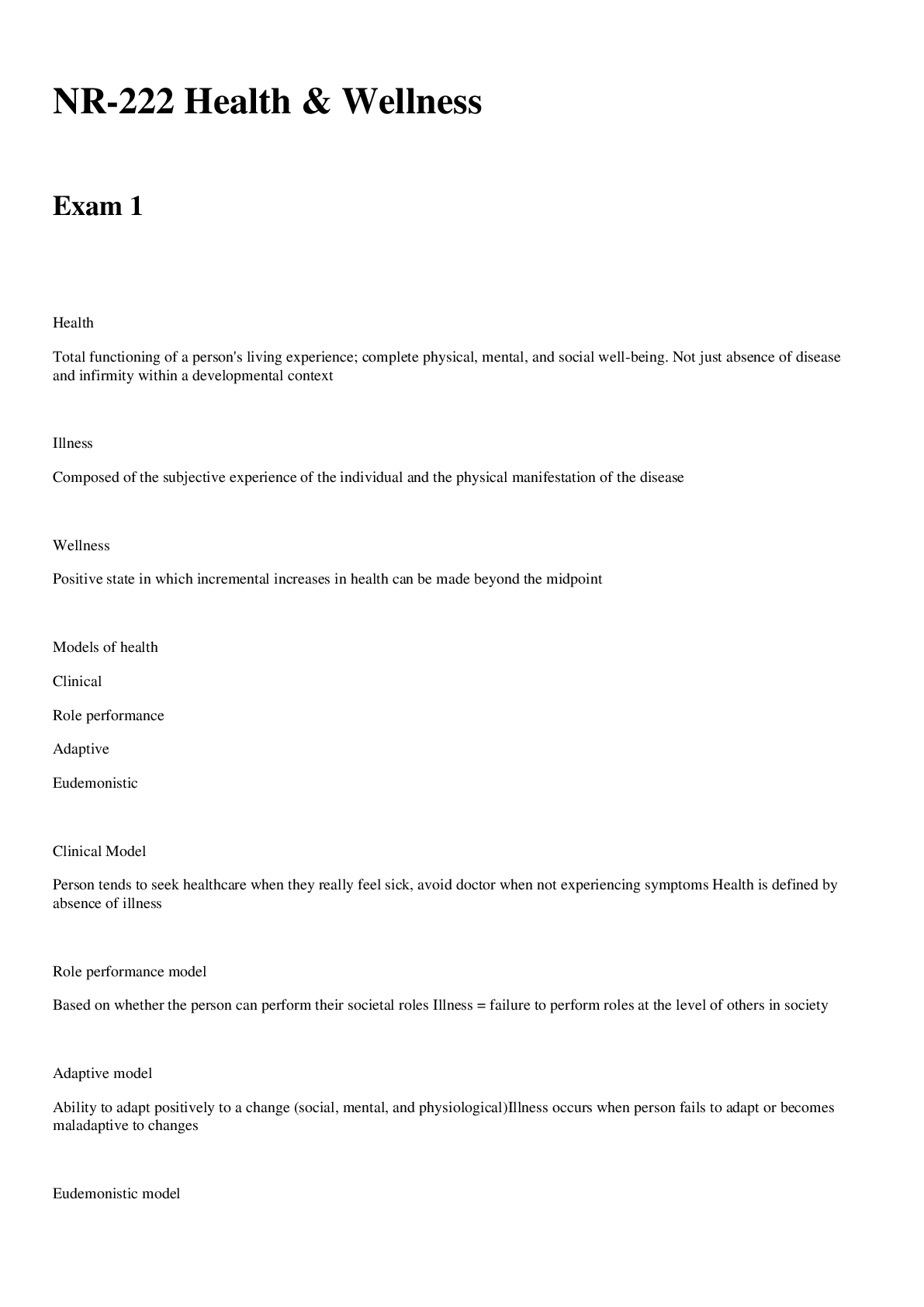
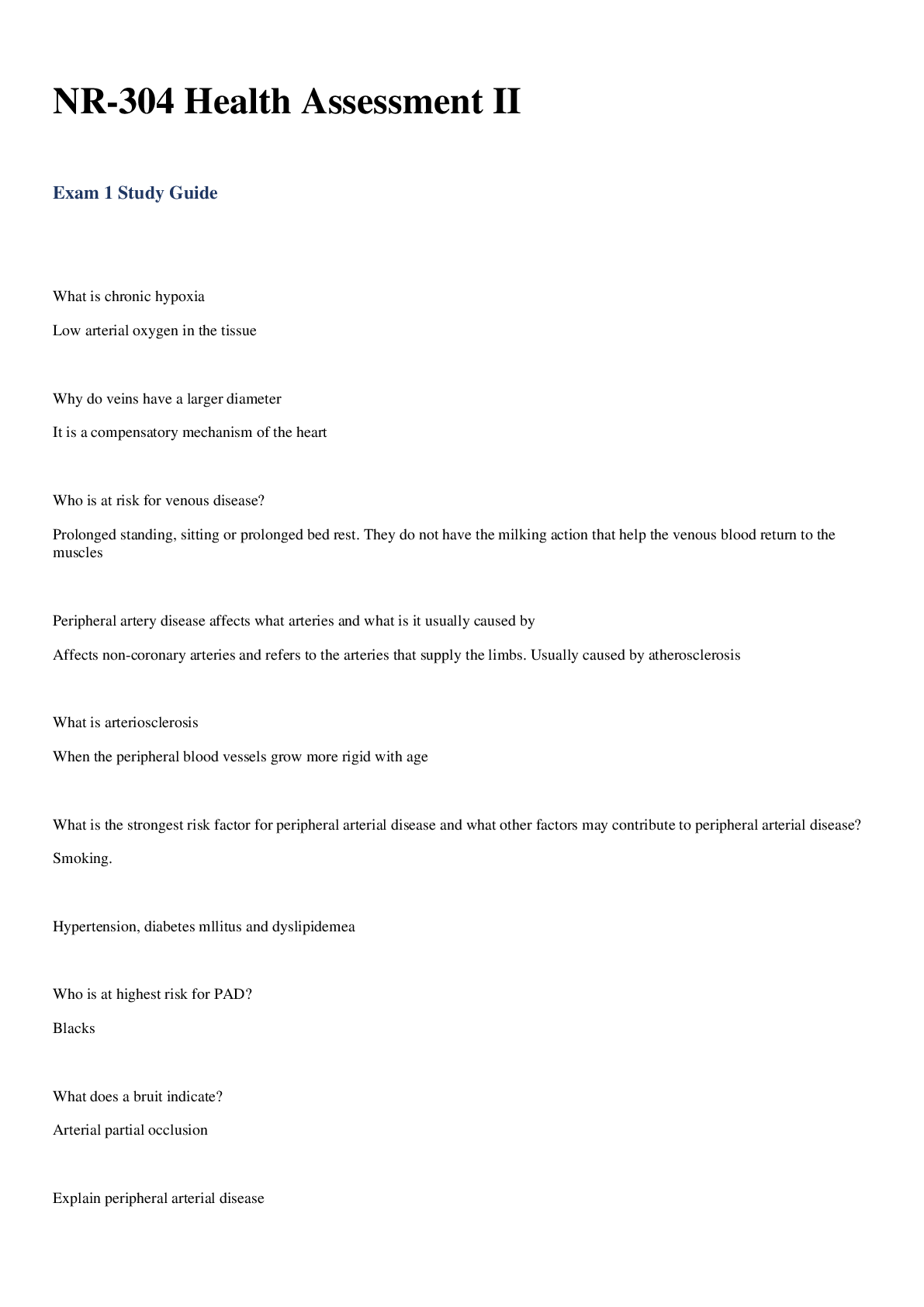
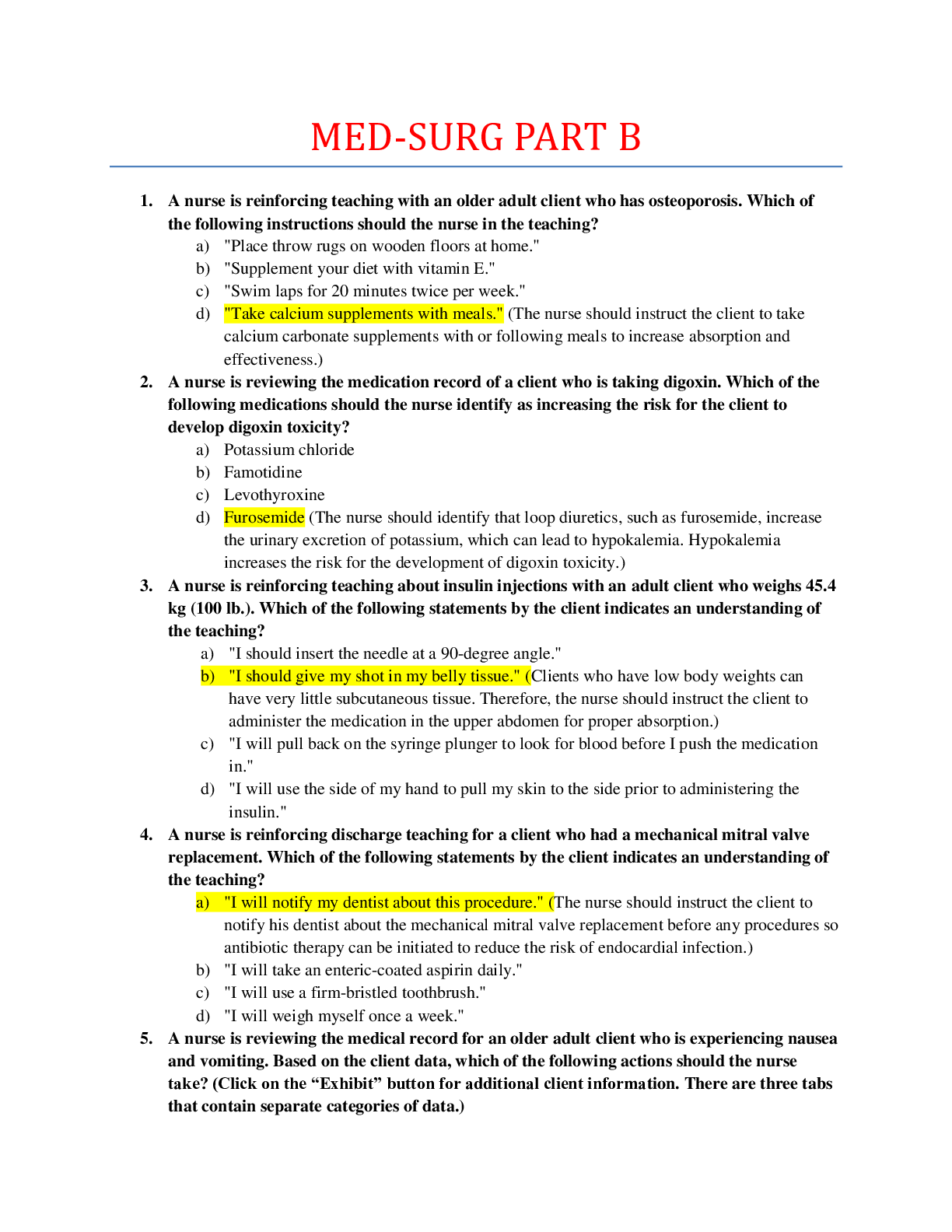
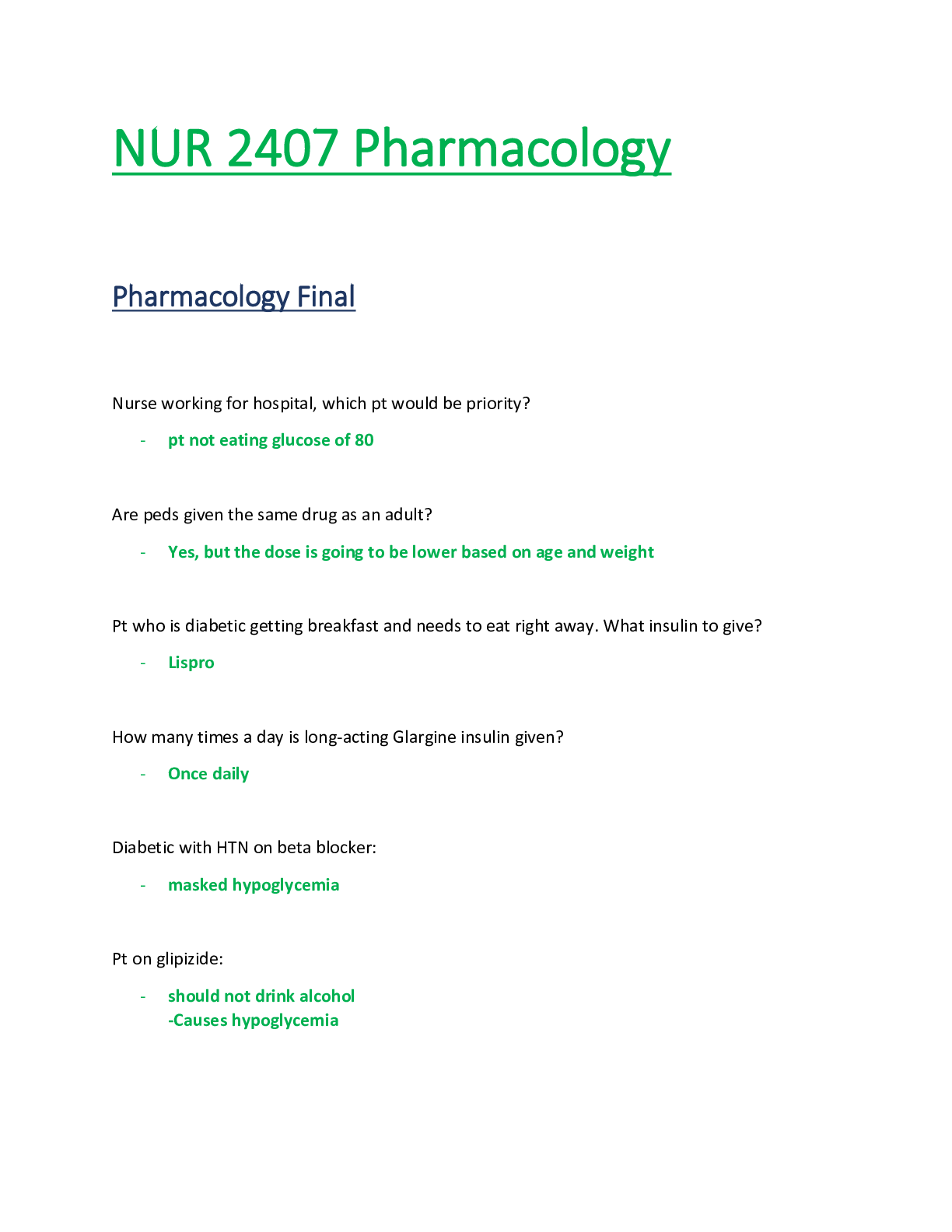
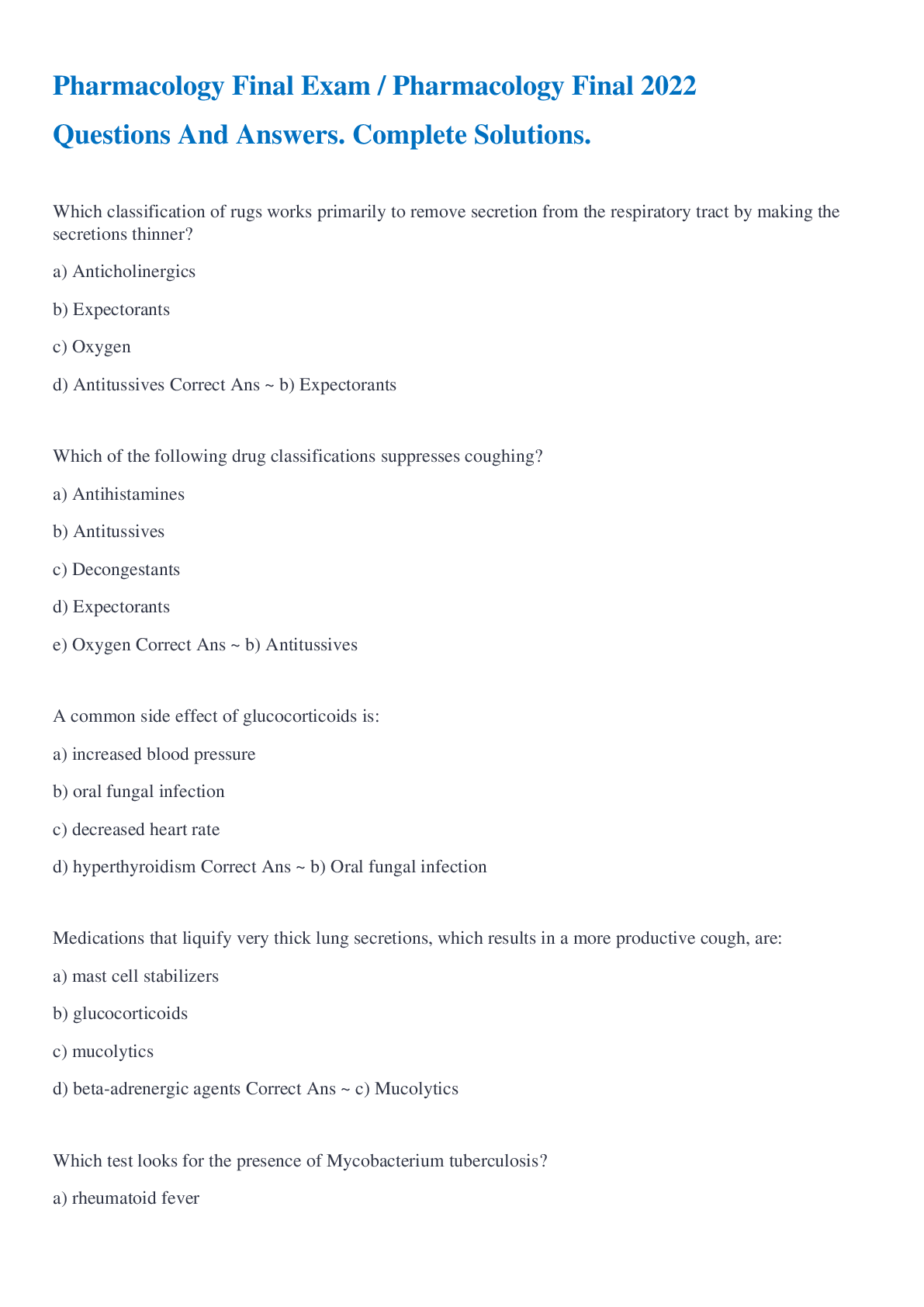
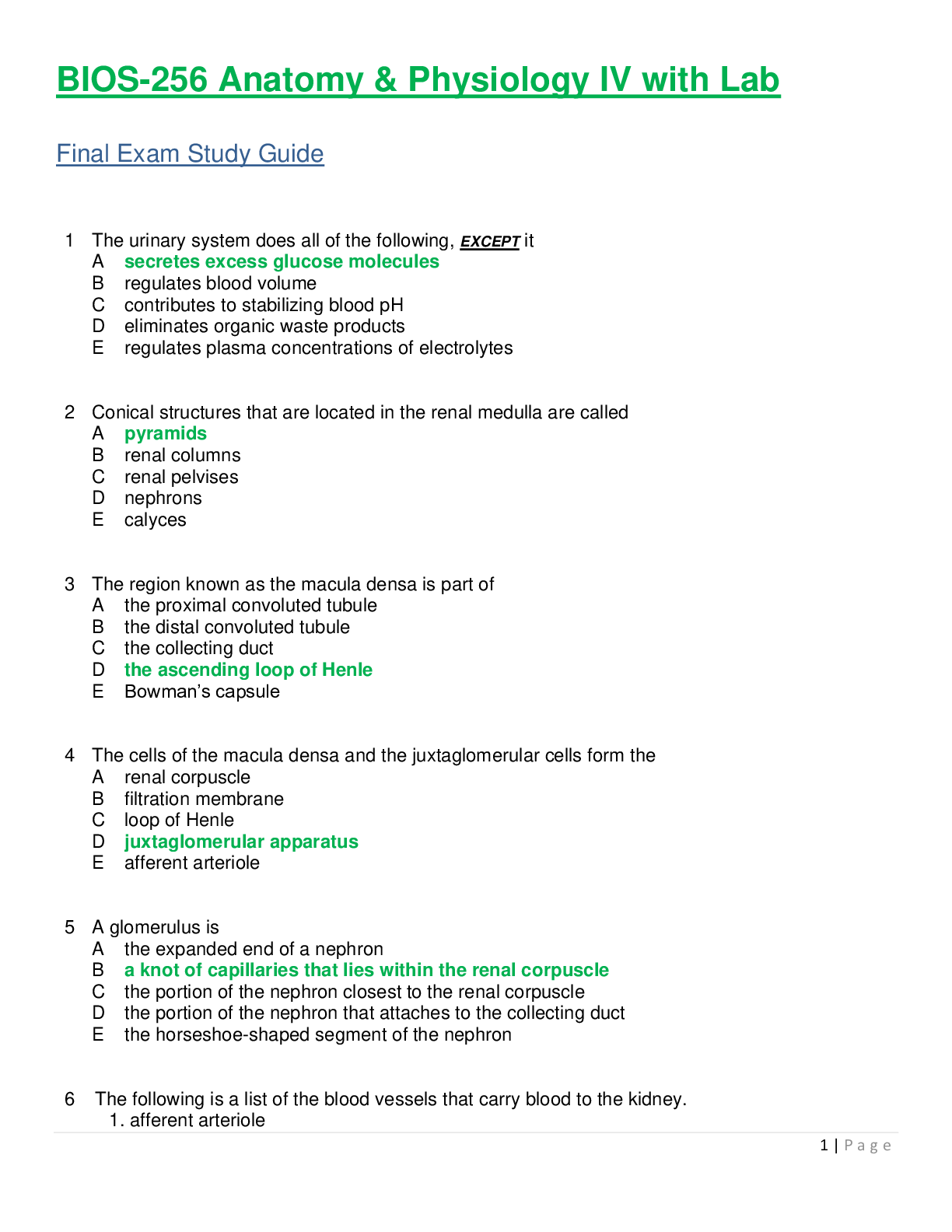
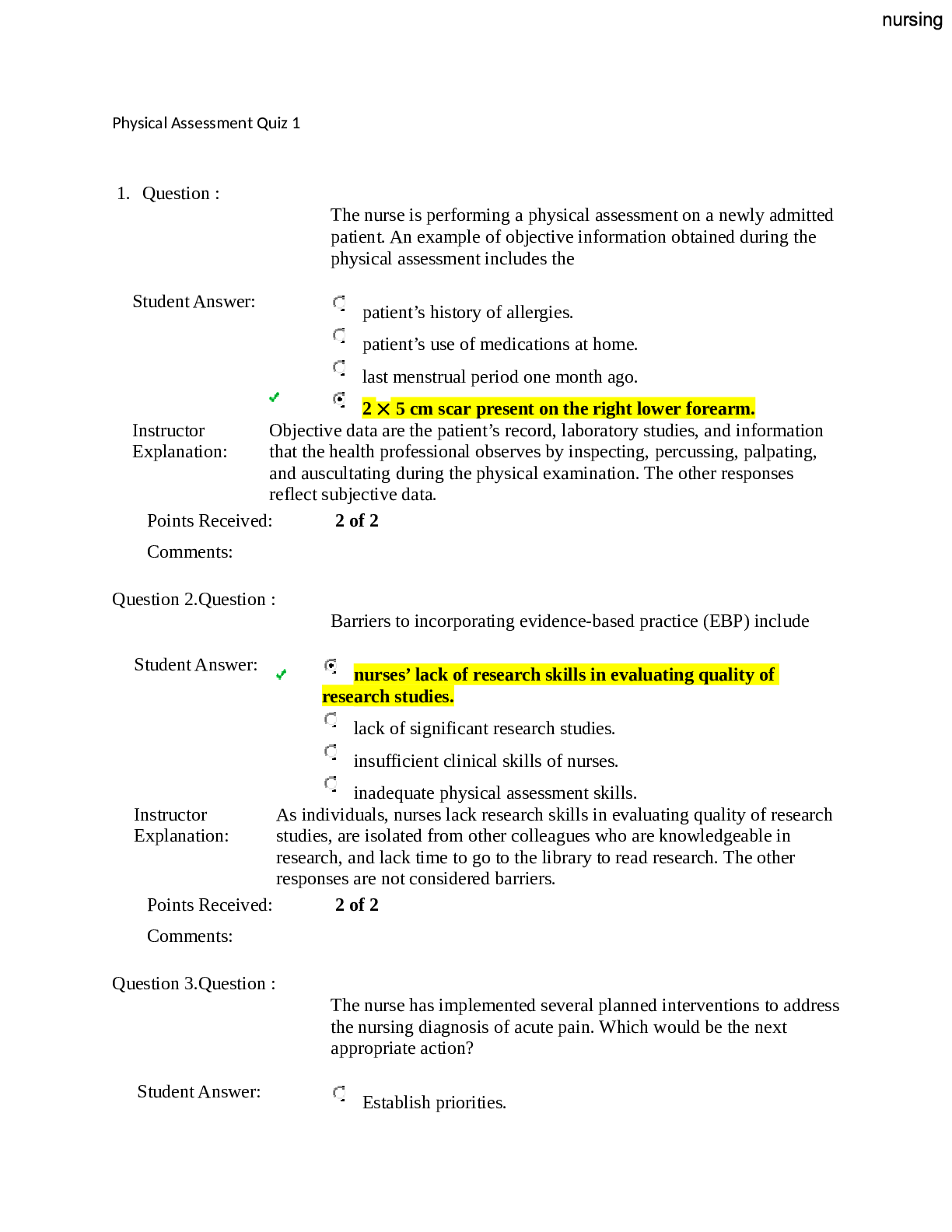

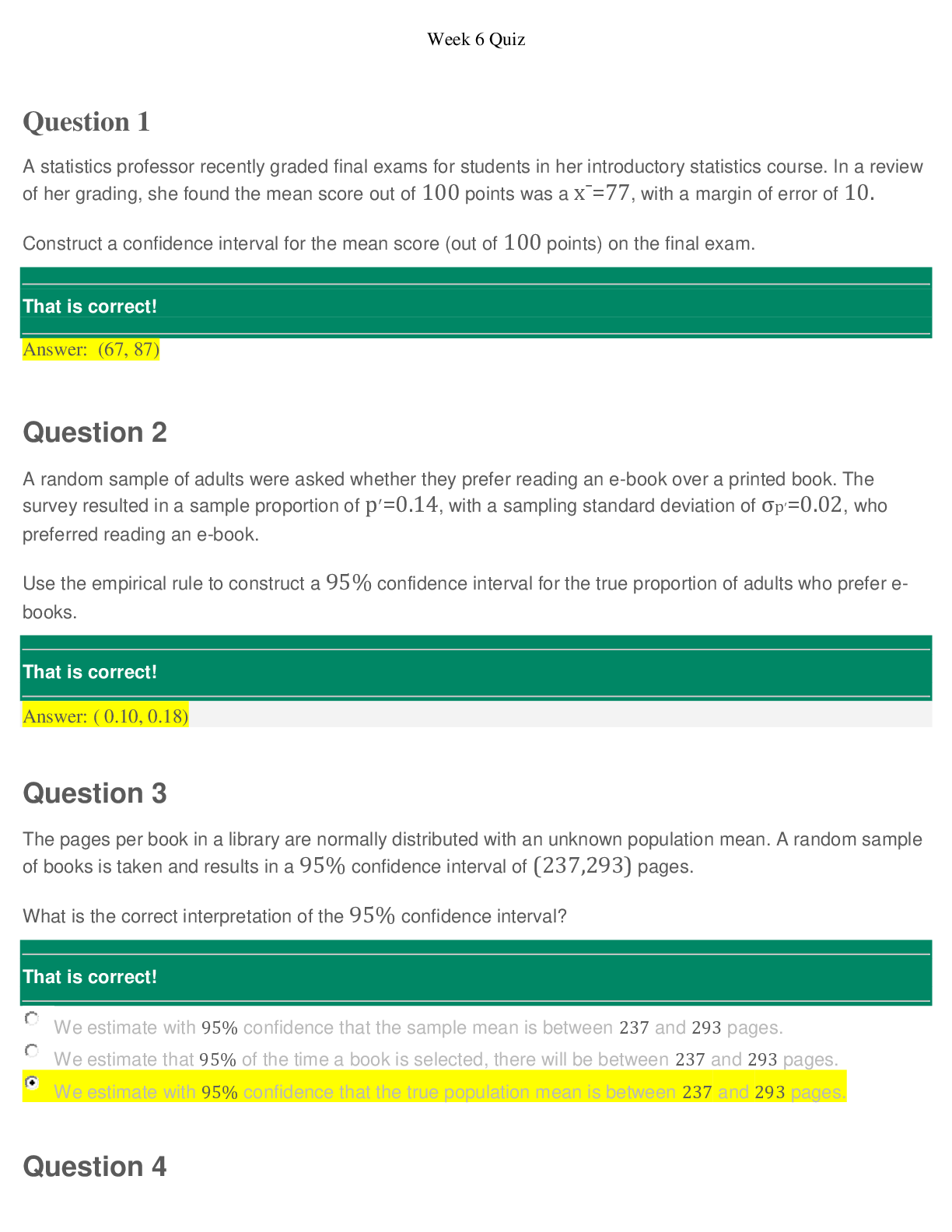
 – CHAMBERLAIN COLLEGE OF NURSING.png)
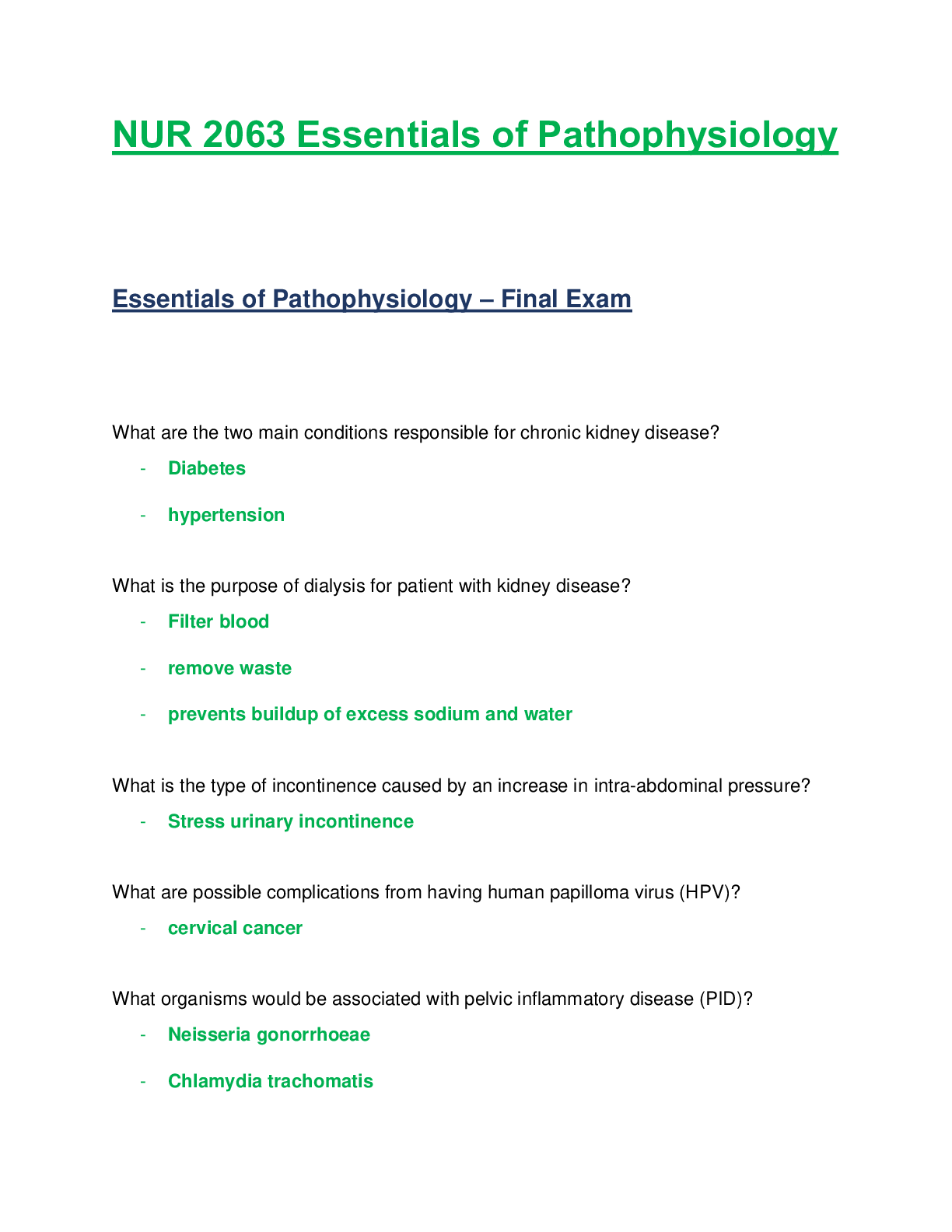
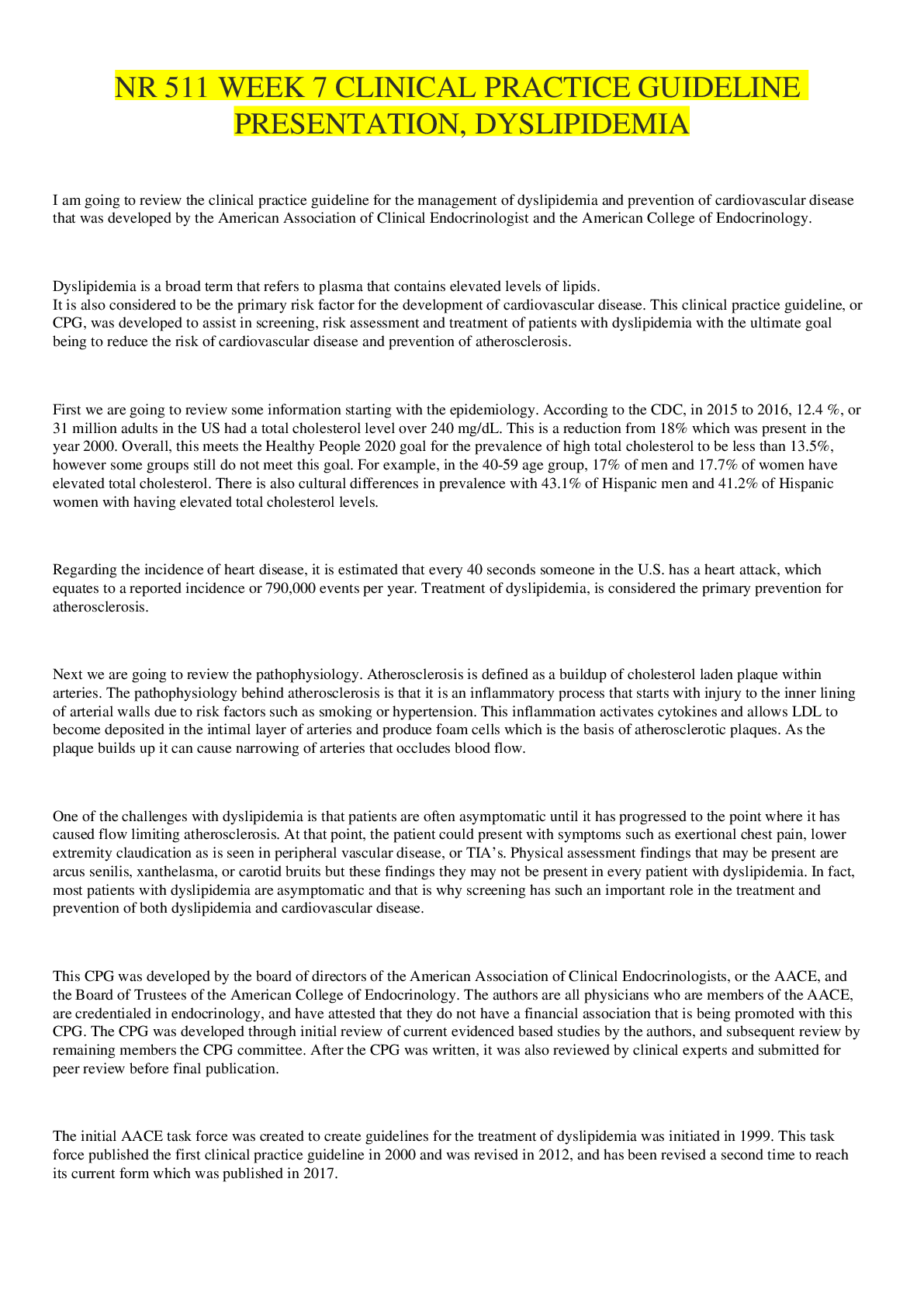
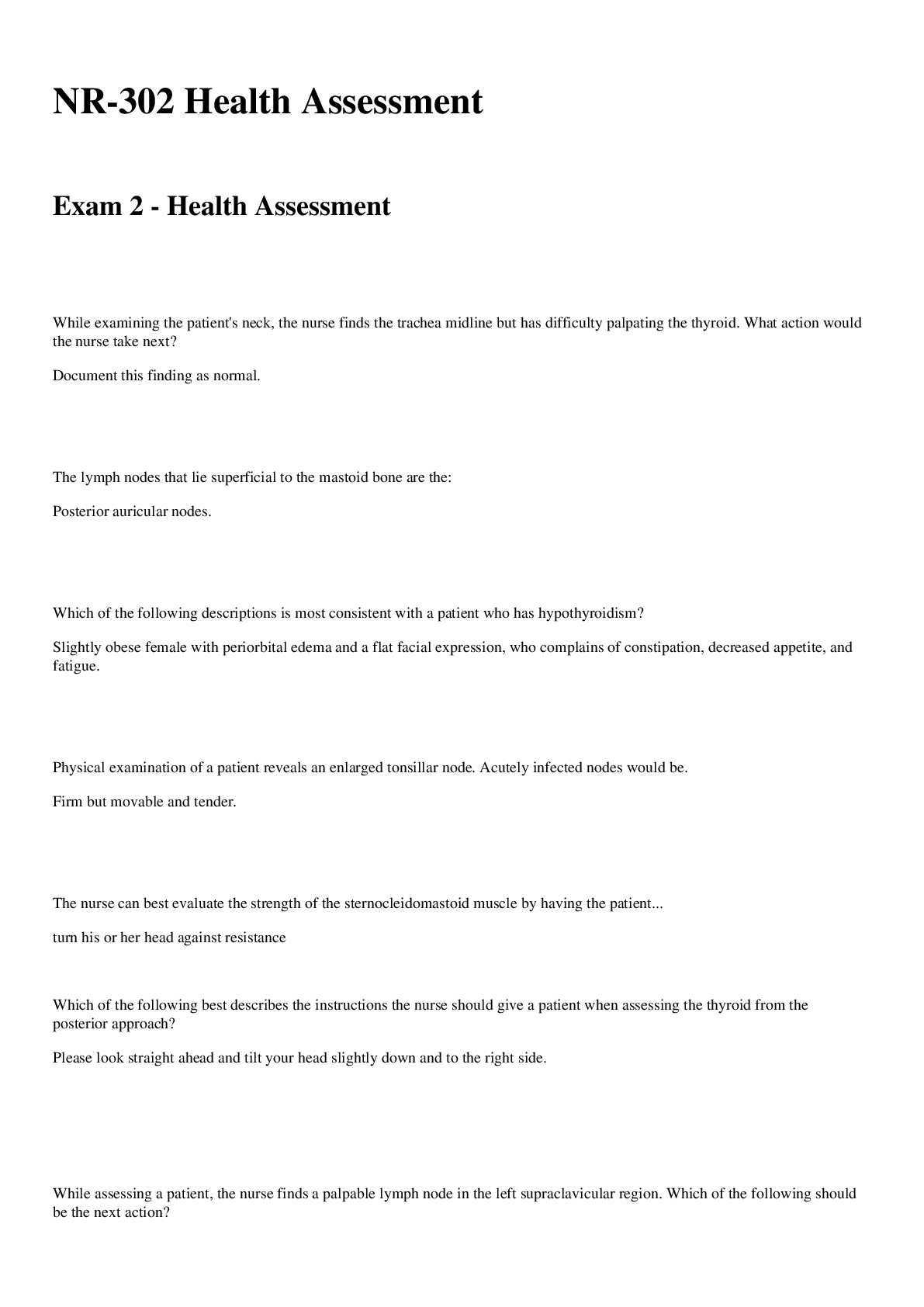
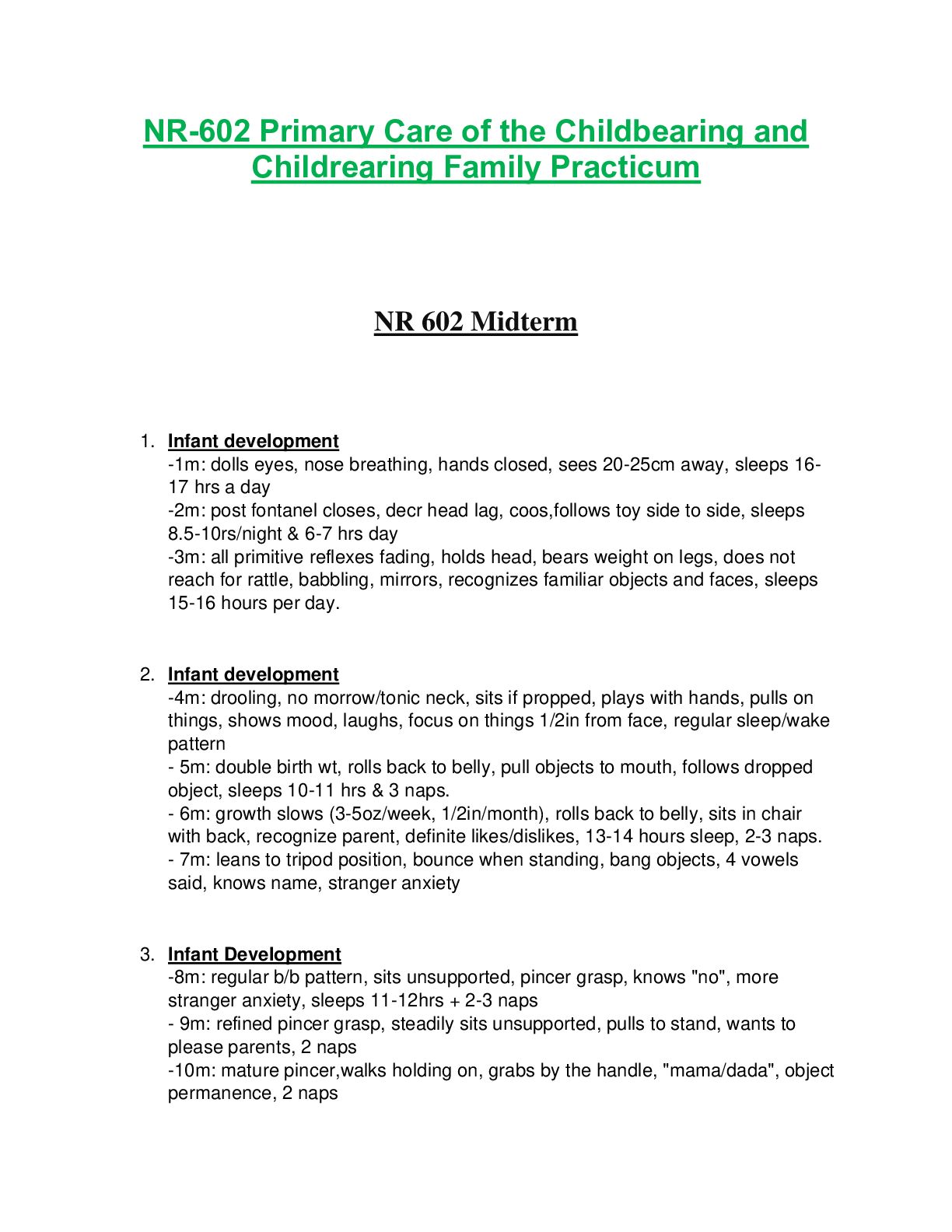
 – Chamberlain College of Nursing.png)

